
Selecting the Right Garden Water Connectors: Tips, Types, and Installation Guidelines

In the realm of gardening, where nature’s artistry intertwines with human care, a seamless irrigation system stands as the lifeline, ensuring that plants and lawns receive the vital hydration they need to thrive. At the heart of this system lie the humble yet essential garden water connectors, the unsung heroes that connect hoses, sprinklers, and other components, orchestrating the smooth flow of water from source to destination. Embark on a journey into the world of garden water connectors, exploring their diverse types, essential considerations, and installation guidelines, transforming your irrigation experience into a symphony of efficiency.
Navigating the Maze of Garden Water Connector Types
As you venture into the aisles of hardware stores or browse online marketplaces, you’ll encounter a dazzling array of garden water connectors, each vying for your attention. To make an informed decision, it’s crucial to understand the distinct characteristics and applications of each type.
Threaded connectors, the most traditional type, feature male and female ends with external and internal threads, respectively. These connectors are renowned for their secure and durable connections, making them ideal for permanent installations.
Quick-connect connectors, also known as push-fit connectors, offer a convenient and hassle-free alternative. These connectors feature a locking mechanism that allows for quick attachment and detachment without the need for tools.
Specialty connectors, designed for specific purposes, cater to unique irrigation needs. Barbed connectors, with sharp teeth that pierce the hose wall, are ideal for attaching hoses to sprinklers or other components. Compression connectors, utilizing a compression sleeve and nut, provide a tight seal for rigid pipes.
Decoding the Factors that Shape Your Choice
Selecting the right garden water connectors is not a mere whim; it’s a strategic decision that aligns with your irrigation needs and preferences. Several factors demand careful consideration to ensure you find the perfect match.
Size: Let the size of your connectors be dictated by the diameter of your hoses and the thread size of the water source or irrigation components. Ensure a mismatch-free connection to prevent leaks and ensure optimal water flow.
Material: Durability, corrosion resistance, and weather tolerance are key considerations when choosing connector material. Brass, renowned for its strength and longevity, is a popular choice. Plastic, lightweight and affordable, is suitable for temporary use. Stainless steel, offering superior corrosion resistance, is ideal for outdoor applications.
Features: Additional features can enhance your irrigation experience. Leak-proof gaskets prevent water loss, swivel connections eliminate hose twisting, and integrated filters protect against debris.
Brands that Elevate the Garden Water Connector Experience
In the realm of garden water connectors, certain brands stand out as beacons of quality and performance, earning the trust of gardeners worldwide.
Melnor, a renowned American brand, is celebrated for its innovative designs and user-friendly features. Their connectors are known for their leak-proof seals, swivel connections, and ergonomic grips.
Gilmour, another American stalwart, has garnered a reputation for its durable construction and reliable performance. Their connectors are crafted from high-quality materials and feature rugged designs to withstand demanding use.
Dramm, a family-owned American company, prides itself on crafting premium connectors using the finest materials. Their connectors are known for their exceptional durability, corrosion resistance, and weather tolerance.
Gardena, a German company with a global presence, brings its expertise in engineering and design to the garden water connector market. Their connectors are known for their innovative features, sleek designs, and European quality.
Nurturing Your Garden Water Connectors to Longevity
Like any faithful companion, your garden water connectors deserve proper care and attention to ensure a long and fruitful partnership. By following these simple guidelines, you’ll extend the life of your connectors and keep them performing at their best.
Cleaning: Regularly inspect your connectors for dirt, debris, and mineral buildup. Clean them periodically using a mild detergent and water solution to prevent corrosion and ensure smooth operation.
Inspection: Before each irrigation season, thoroughly inspect your connectors for leaks, cracks, or signs of wear and tear. Replace any damaged connectors promptly to prevent water loss and potential damage to your irrigation system.
Storage: When not in use, store your connectors in a cool, dry place away from direct sunlight and extreme temperatures. This prevents the connectors from cracking or becoming brittle.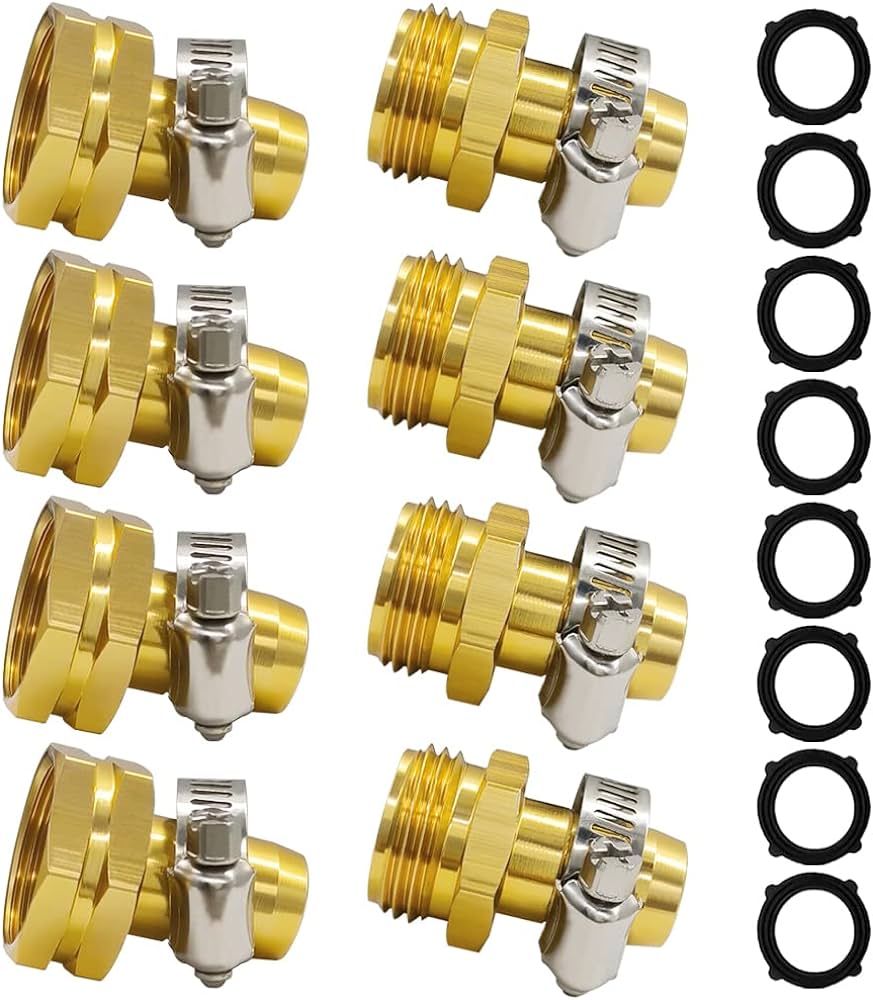
Troubleshooting: Conquering Garden Water Connector Woes
Even the most faithful garden water connectors can encounter occasional challenges. Here’s a roadmap to navigate common problems and restore your connectors to peak performance.
Leaks: Identify the source of the leak by inspecting the connector for damaged gaskets, loose threads, or cracked fittings. Tighten loose connections, replace worn gaskets, or use sealant on threaded connections to stop leaks.
Loose Connections: Tighten loose connections using wrenches or pliers. Avoid overtightening, as this can damage the connector or hose. If the connection remains loose, replace the connector.
Restricted Water Flow: Remove any Restricted Water Flow: Remove any debris that might be lodged within the connector by flushing it with clean water. If the issue persists, the filter (if present) might be clogged. Clean or replace the filter to restore normal water flow.
Safety First: A Gardener’s Pledge
Safety is paramount when wielding your garden water connectors. Here are some precautions to keep in mind:
Water Pressure: Exercise caution when dealing with pressurized water systems. Leaks or loose connections can cause forceful water sprays that can lead to injuries. Turn off the water supply before starting any maintenance or repairs.
Electrical Hazards: Keep your connectors away from electrical cords and power tools to prevent potential shocks. Disconnect electrical devices before connecting or disconnecting hoses.
Supervision: Supervise children and pets around running water to prevent accidents or unsupervised water play.
A Universe of Garden Water Connector Accessories
A plethora of garden water connector accessories awaits to enhance your irrigation experience and transform your connectors into multifunctional tools.
Adapters and Reducers: Utilize adapters and reducers to connect components with different thread sizes, ensuring seamless compatibility within your irrigation system.
Extensions: Invest in hose extensions to connect distant watering points or expand the reach of your hose without the need for additional connections. This minimizes leaks and simplifies watering tasks.
Shut-off Valves: Install shut-off valves at strategic points in your irrigation system to control water flow to specific areas or isolate sections for repairs. This allows for targeted watering and simplifies maintenance.
The Final Bloom: A Garden Water Connector Odyssey Concludes
By demystifying the world of garden water connectors, from their various types and features to essential care and troubleshooting techniques, you are now equipped to make informed decisions and utilize your connectors effectively. Remember, the right connectors, coupled with proper care and maintenance, become the silent heroes of your irrigation system, ensuring a smooth flow of life-giving water to your cherished plants and lawns. Explore the vast array of connectors and accessories available, and embark on a journey of creating a thriving oasis, all thanks to the silent but essential heroes – garden water connectors.
Bonus: Unveiling Additional Resources
To further enhance your irrigation expertise, delve into the following resources:
- Online garden water connector reviews and comparisons to identify the perfect connectors for your needs.
- Irrigation system guides packed with valuable tips on system design, component selection, and installation techniques.
- DIY garden water connector repair tutorials to equip you with the knowledge to tackle minor connector issues.
- Reputable gardening websites and forums to connect with fellow gardening enthusiasts and glean valuable insights on irrigation best practices.
- Local hardware stores staffed with knowledgeable experts who can offer personalized advice and recommendations on garden water connector selection and installation.
With this wealth of information at your disposal, you are well on your way to becoming a garden water connector maestro, ensuring your irrigation system functions flawlessly, transforming your garden into a haven of flourishing beauty.

Garden Hoses: Choosing the Right Type, Maintenance, and Best Practices

Navigating the Maze of Garden Hose Types
As you venture into the aisles of hardware stores or browse online marketplaces, you’ll encounter a dazzling array of garden hoses, each vying for your attention. To make an informed decision, it’s crucial to understand the distinct characteristics and benefits of each type.
Vinyl hoses, the most common and affordable option, are crafted from durable PVC material, offering lightweight flexibility and resistance to UV rays. However, their lifespan may be shorter compared to other types.
Rubber hoses, renowned for their exceptional durability and strength, are constructed from heavy-duty rubber, providing superior resistance to kinks, abrasion, and extreme temperatures. Their sturdiness comes at a higher price point.
Hybrid hoses, a harmonious blend of vinyl and rubber, combine the affordability of vinyl with the durability of rubber. Their reinforced construction offers a balance between performance and cost.
Specialty hoses, designed for specific applications, cater to unique gardening needs. Soaker hoses, with porous walls, are ideal for sub-surface irrigation, while expandable hoses, compact and lightweight, contract when not in use for easy storage.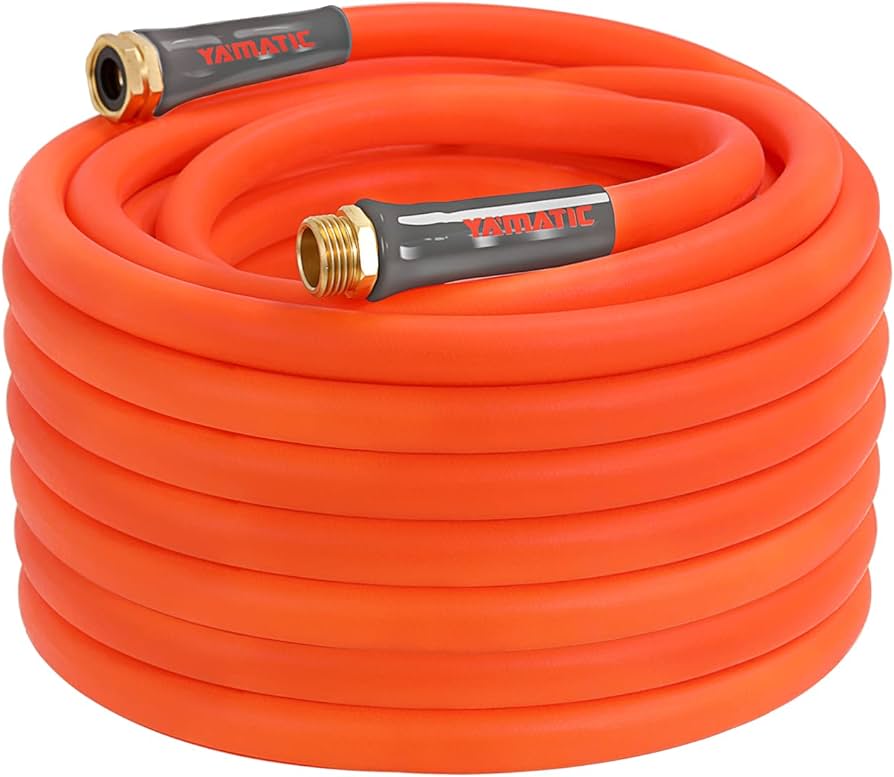
Decoding the Factors that Shape Your Choice
Selecting the right garden hose is not a mere whim; it’s a strategic decision that aligns with your gardening needs and preferences. Several factors demand careful consideration to ensure you find the perfect match.
Length: Let the length of your hose be dictated by the distance between your water source and the furthest watering point. Avoid excessive length, as it can lead to water pressure loss and unnecessary weight.
Diameter: The diameter of your hose determines water flow and pressure. A wider diameter hose delivers water faster and with more force, ideal for larger lawns or tasks requiring high pressure. For smaller gardens or delicate plants, a narrower diameter hose may be sufficient.
Material: Durability, flexibility, and weather resistance are key considerations when choosing hose material. Vinyl offers affordability and flexibility, rubber boasts durability and strength, while hybrid hoses strike a balance.
Features: Additional features can enhance your gardening experience. Kink resistance prevents frustrating interruptions, burst resistance protects against water damage, crush resistance ensures durability, and swiveling connections prevent hose twisting.
Brands that Elevate the Garden Hose Experience
In the realm of garden hoses, certain brands stand out as beacons of quality and performance, earning the trust of gardeners worldwide.
Gilmour, a renowned American brand, is celebrated for its innovative designs and durable construction. Their hoses are known for their kink resistance, crush resistance, and comfortable grips.
Melnor, another American stalwart, has garnered a reputation for its user-friendly features and affordable prices. Their hoses often feature swiveling connections, ergonomic handles, and innovative watering nozzles.
Dramm, a family-owned American company, prides itself on crafting high-quality hoses using premium materials. Their hoses are known for their exceptional durability, kink resistance, and weather resistance.
Goodyear, a global leader in tire manufacturing, brings its expertise in rubber technology to the garden hose market. Their hoses are renowned for their superior strength, flexibility, and resistance to extreme temperatures.
Nurturing Your Garden Hose to Longevity
Like any faithful companion, your garden hose deserves proper care and attention to ensure a long and fruitful partnership. By following these simple guidelines, you’ll extend the life of your hose and keep it performing at its best.
Storage: When not in use, coil your hose neatly and store it in a cool, shaded area, away from direct sunlight and extreme temperatures. This prevents the hose from cracking or becoming brittle.
Prevention: Avoid dragging your hose over rough surfaces or sharp objects, which can cause damage. Also, keep it away from electrical cords and power tools to prevent potential hazards.
Cleaning: Regularly inspect your hose for leaks and damage. If you notice any issues, address them promptly. Clean the hose periodically to remove dirt, debris, and mildew buildup.
Replacement: As your hose ages, it may become more susceptible to leaks and kinks. When signs of wear and tear become evident, consider replacing your hose with a new one to ensure optimal performance.
Watering Wisdom: Unleashing the Power of Your Garden Hose
With your trusty garden hose in hand, it’s time to transform your watering technique into an art form. Embrace these tips to maximize efficiency and conserve water while nourishing your plants and lawns.
Effective Watering: Water your plants deeply but infrequently, targeting the root zone instead of the leaves. Early morning or late evening watering minimizes evaporation and ensures maximum water absorption.
Harnessing Attachments: Utilize watering nozzles or sprinklers to control water flow and distribution. Choose nozzles with adjustable spray patterns for precise watering of delicate plants or powerful bursts for cleaning decks.
Conservation Champions: Embrace water conservation practices. Consider using a hose timer to automate watering and prevent overwatering. Utilize a rain barrel to collect rainwater for a more sustainable watering solution.
Troubleshooting: Conquering Garden Hose Woes
Even the most faithful garden hoses can encounter occasional challenges. Here’s a roadmap to navigate common problems and restore your hose to peak performance.
Leaks: Identify the source of the leak by inspecting the hose for cracks or loose connections. Tighten loose connections or replace damaged sections with hose repair kits.
Kinks: Kinks can disrupt water flow and damage your hose. To prevent kinks, choose a kink-resistant hose and avoid sharp bends or twists while storing or using it. If a kink occurs, gently straighten the hose without applying excessive force.
Low Pressure: Low water pressure can hinder effective watering. Check for leaks or blockages in the hose or at the water source. Ensure a tight connection between the hose and the faucet. If the issue persists, consult a plumber to rule out water pressure problems within your house.
Safety First: A Gardener’s Pledge
Safety is paramount when wielding your garden hose. Here are some precautions to keep in mind:
Electrical Hazards: Keep your hose away from electrical cords and power tools to prevent potential shocks.
Mind the Pressure: Exercise caution when using your hose under pressure. Avoid spraying yourself or others with high-powered water streams.
Supervise Playtime: Keep children and pets away from running hoses to prevent accidents or unsupervised water play.
A Universe of Garden Hose Accessories
A plethora of garden hose accessories awaits to enhance your watering experience and transform your hose into a multifunctional tool.
Nozzles and Sprinklers: Explore a diverse range of nozzles and sprinklers, each offering unique spray patterns and watering capabilities.
Timers and Reels: Utilize hose timers for automated watering schedules and hose reels for convenient storage and handling of your hose.
Guides and Supports: Invest in hose guides or wall-mounted hose hangers to prevent tangles and keep your hose organized.
The Final Bloom: A Garden Hose Odyssey Concludes
By demystifying the world of garden hoses, from their various types and features to essential care and troubleshooting techniques, you are now equipped to make informed decisions and utilize your hose effectively. Remember, the right hose, coupled with proper care and mindful watering practices, becomes an extension of your gardening passion, nurturing vibrant landscapes and flourishing plant life. Explore the vast array of hoses and accessories available, and embark on a journey of discovery, transforming your garden into a haven of flourishing beauty, all thanks to the silent hero – the garden hose.
Bonus: Unveiling Additional Resources
To further enhance your gardening expertise, delve into the following resources:
- Online hose reviews and comparisons to identify the perfect hose for your needs.
- Watering guides packed with valuable tips on proper watering techniques and plant-specific watering requirements.
- DIY garden hose repair tutorials to equip you with the knowledge to tackle minor hose issues.
- Reputable gardening websites and forums to connect with fellow gardening enthusiasts and glean valuable insights.
- Local gardening centers staffed with knowledgeable experts who can offer personalized advice and recommendations.
With this wealth of information at your disposal, you are well on your way to becoming a garden hose maestro, ensuring your plants and lawns receive the care they deserve to thrive for seasons to come.

Serrated Hand Shovel for Effortless Digging

In the realm of gardening tools, the humble hand shovel stands as a versatile and indispensable companion for tasks ranging from planting seedlings to transplanting mature shrubs. However, when tackling tough terrain or stubborn roots, traditional shovels can meet their match. This is where the serrated hand shovel emerges as a game-changer, revolutionizing the way gardeners approach digging and landscaping projects.
Unveiling the Power of Serrated Blades
Serrated hand shovels, as the name suggests, feature a blade adorned with teeth that resemble those of a saw. These strategically placed serrations are the key to their superior performance, transforming the digging experience from a struggle to a smooth, effortless process.
Imagine attempting to dig through a bed of dense, root-bound soil with a traditional shovel. The smooth blade would likely glide over the roots, leaving them intact and hindering your progress. With a serrated hand shovel, however, the story is entirely different. The serrations act like tiny knives, slicing through roots and compacted soil with ease, making even the most challenging digging tasks a breeze.
Design and Construction: A Closer Look
Beyond their serrated blades, serrated hand shovels boast a range of design features that enhance their functionality and durability.
-
Blade Material: Serrated hand shovel blades are typically crafted from high-quality carbon steel or stainless steel. These materials provide the necessary strength and resistance to wear and tear, ensuring that your shovel can handle even the most demanding digging jobs.
-
Handle Design: Ergonomics plays a crucial role in the design of serrated hand shovels. Many models feature comfortable, non-slip grips that reduce hand fatigue and provide a secure hold, even when your hands are wet or sweaty. Additionally, some handles incorporate shock-absorbing features to minimize the impact on your joints and wrists.
Popular Serrated Hand Shovels on the Market
With a growing recognition of their benefits, serrated hand shovels are gaining popularity among gardeners of all levels. Here are a few highly rated options to consider:
-
Fiskars X27 Super Sharp Serrated Transplanter: This lightweight and versatile shovel features a razor-sharp serrated blade and an ergonomic handle, making it ideal for transplanting, weeding, and other delicate tasks.
-
Bully Tools 16-Inch Transplanter with Serrated Edge: This heavy-duty shovel boasts a durable carbon steel blade with aggressive serrations, perfect for tackling tough digging jobs in rocky or root-bound soil.
-
AMES 14-Inch Serrated Edge Transplanter: This classic design features a stainless steel blade with fine serrations, making it a great choice for precise digging around delicate plants and bulbs.

Choosing the Right Serrated Hand Shovel for Your Needs
Selecting the right serrated hand shovel depends on several factors, including the size of your garden, the type of soil you have, the tasks you’ll be using it for, and your personal preferences.
-
Blade Size and Shape: Consider the size of the planting holes or trenches you’ll be digging when choosing a blade size. The shape of the blade can also be important; a pointed blade is ideal for digging in tight spaces, while a wider blade is better for moving larger amounts of soil.
-
Handle Length and Grip: The length of the handle should be comfortable for your height and digging style. A longer handle provides more leverage for tough digging, while a shorter handle offers better maneuverability in tight spaces. The grip material should be comfortable and non-slip to prevent blisters and fatigue.
Techniques for Mastering Serrated Hand Shovel Digging
To fully harness the power of your serrated hand shovel, employ proper digging techniques:
-
Stance and Grip: Stand with your feet shoulder-width apart and your knees slightly bent. Grip the handle firmly with both hands, one near the top and the other closer to the blade.
-
Utilizing the Serrations: When encountering roots or tough soil, angle the blade slightly and use a sawing motion to cut through the material. The serrations will do the work, making digging easier and more efficient.
-
Leveraging the Blade: For lifting soil or plants, use the full length of the handle and your body weight to leverage the blade. This will make lifting easier and reduce strain on your back.

Maintaining Your Serrated Hand Shovel for Optimal Performance
Proper care will ensure that your serrated hand shovel remains a reliable garden companion for years to come:
-
Cleaning and Drying: After each use, wash the blade and handle with soapy water and dry them thoroughly to prevent rust and corrosion.
-
Sharpening the Serrations: Over time, the serrations may become dull. Use a sharpening file or whetstone to maintain their sharpness for optimal digging performance.
-
Proper Storage: Store your shovel in a dry, protected location when not in use. Hanging it on a wall or storing it in a tool shed will help prevent damage.
-
Troubleshooting Common Issues and Maintaining Safety
Even the most durable tools can encounter occasional problems. Here’s how to address common issues with your serrated hand shovel:
-
Bent or Damaged Blades: Minor bends can sometimes be straightened with care. However, for severe bends or cracks, replacing the blade is necessary to ensure safety and functionality.
-
Loose or Wobbly Handles: Tighten any loose screws or bolts securing the handle. If the handle itself is damaged, consider replacing it for optimal control and safety.
-
Blade Coating Issues (if applicable): Some serrated hand shovels feature a protective coating on the blade. If the coating becomes chipped or damaged, refer to the manufacturer’s instructions for recommendations on repair or replacement.
Safety should always be a priority when using any gardening tool. Here are some essential safety precautions to remember with serrated hand shovels:
-
Avoid Blade Contact: Always keep your hands and fingers away from the blade while digging to prevent accidental cuts.
-
Wear Protective Gloves: Wearing gardening gloves protects your hands from blisters, cuts, and dirt while digging.
-
Maintain Situational Awareness: Be mindful of your surroundings and potential hazards like underground utilities or sprinkler lines before digging.
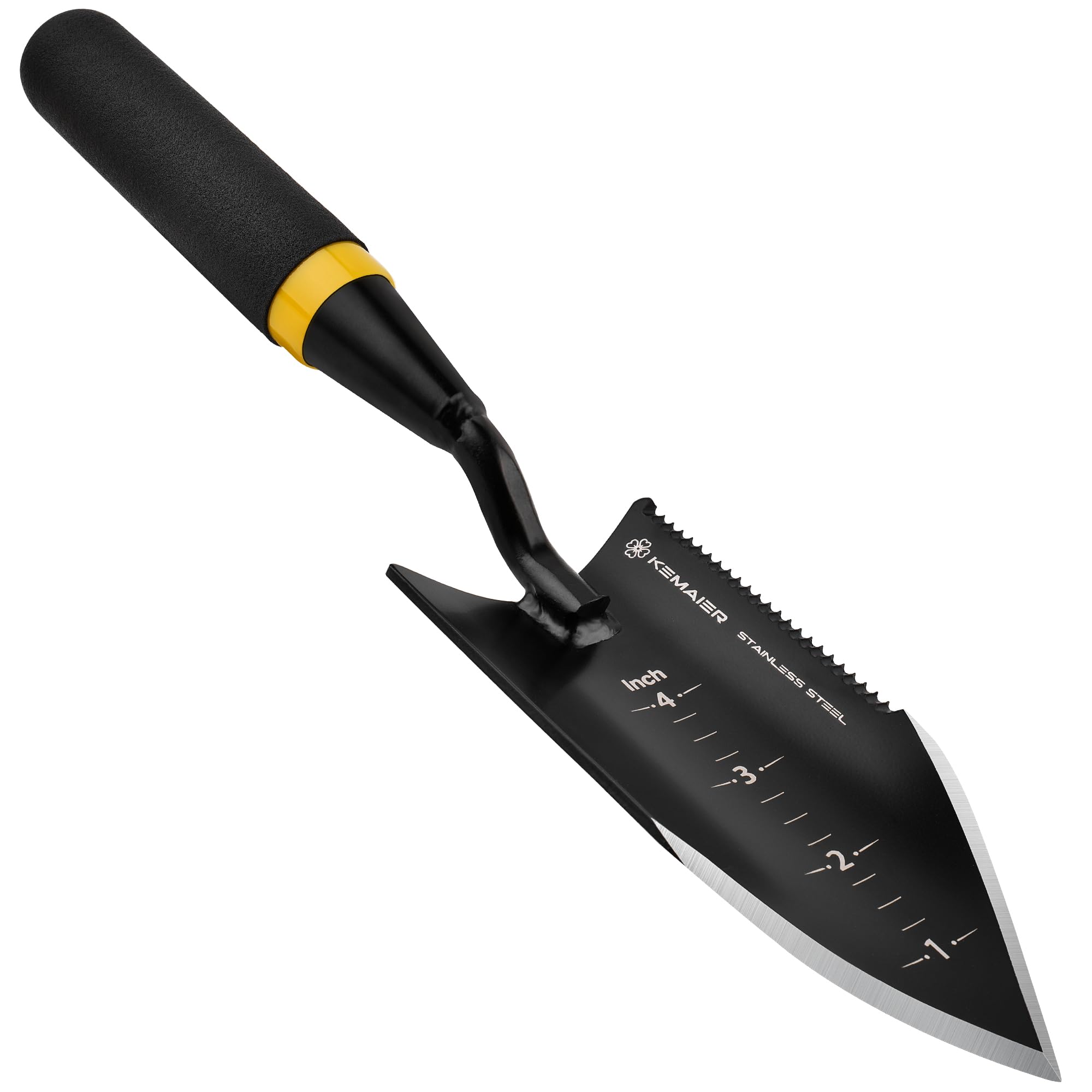
Optimizing Your Digging Experience with Additional Tips
By incorporating these additional tips into your gardening routine, you can further enhance your experience with a serrated hand shovel:
-
Choosing the Right Time to Dig: Early mornings or evenings are ideal times to dig when the soil is cooler and more moist, making it easier to work with.
-
Loosening the Soil: Before digging, especially in compacted areas, use a garden fork or a tool like a broadfork to break up the soil. This will make it significantly easier to penetrate with your serrated hand shovel.
-
Utilizing a Digging Fork: For particularly stubborn roots or rocky soil, consider using a digging fork in conjunction with your serrated hand shovel. The digging fork can help loosen the soil and break up large roots, making it easier to manage with the shovel.
Conclusion: A Worthy Investment for Every Gardener’s Arsenal
Serrated hand shovels are a valuable addition to any gardener’s toolkit. Their ability to tackle tough digging tasks with ease, coupled with their versatility and comfortable design, makes them a game-changer for various gardening projects. Whether you’re a seasoned green thumb or a budding enthusiast, a serrated hand shovel can empower you to conquer challenges, cultivate success, and experience the joy of effortless digging in your garden.
-

Trim with Ease: Fiskars Shear Ease Grass Shears
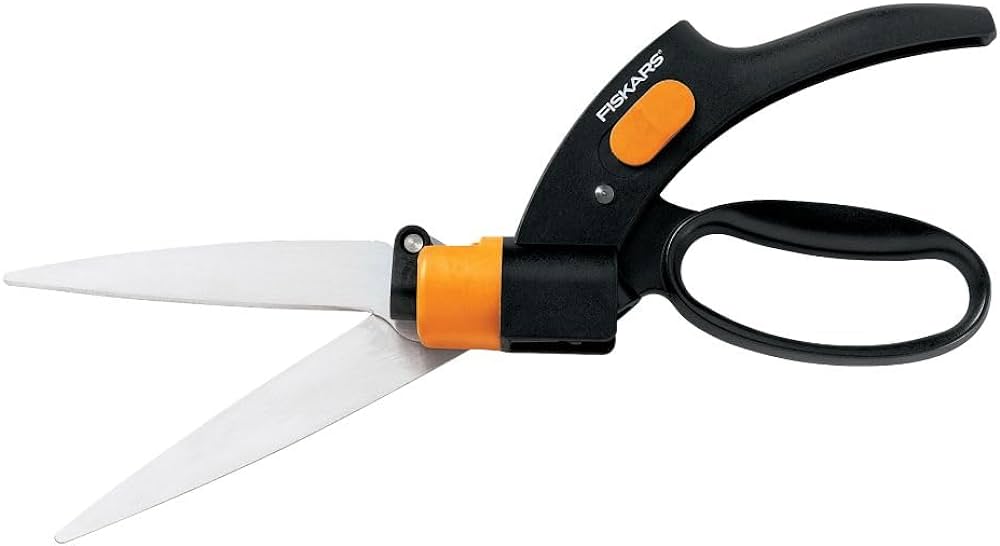
A well-manicured lawn is not only aesthetically pleasing but also contributes to the overall health and vitality of your outdoor space. However, maintaining the edges and borders of your lawn can be a tedious task, often requiring the use of bulky trimmers or time-consuming hand trimming. Enter the Fiskars Shear Ease Grass Shears, a revolutionary tool that empowers gardeners to achieve precise and effortless grass trimming with minimal strain.
Unboxing and Design Highlights
Upon receiving your Fiskars Shear Ease Grass Shears, you’ll discover a package containing the shears themselves, a protective blade cover, and clear instructions for assembly and use. The shears immediately impress with their sleek, ergonomic design, featuring lightweight aluminum handles and comfortable non-slip grips. The blades, crafted from high-quality hardened steel, exude durability and sharpness, promising years of reliable performance.
Effortless Operation and Versatility
Operating the Fiskars Shear Ease Grass Shears is a breeze. The natural grip position ensures a comfortable hold, while the rotating head allows you to adjust the cutting angle for optimal trimming at various heights and angles. The shears’ unique Shear Ease mechanism prevents the blades from jamming, ensuring smooth and effortless operation even through thick or overgrown grass.
Maintenance and Longevity
Proper care will ensure that your Fiskars Shear Ease Grass Shears remain in top condition for years to come. After each use, wipe down the blades and handle with a damp cloth to remove dirt and debris. Periodically sharpen the blades using a whetstone or honing tool to maintain their sharpness. When not in use, store the shears in their protective blade cover to prevent damage.
Troubleshooting Common Issues
Should you encounter any issues with your Fiskars Shear Ease Grass Shears, fret not. For jammed blades, simply open and close the shears repeatedly to dislodge any trapped grass or debris. If the blades are bent or damaged, they can be replaced with genuine Fiskars replacement blades. For issues with the rotating head mechanism, refer to the instruction manual for detailed troubleshooting steps.
Tips for Effective Grass Trimming
To achieve the best results when trimming your grass, consider these tips:
-
Timing is key: Trim your grass during the cooler morning or evening hours to avoid heat stress on the plants.
-
Preparation is essential: Ensure the grass is dry and free from debris before trimming.
-
Efficiency and safety: Use long, sweeping motions to trim efficiently, and always maintain a stable stance while trimming.

Safety Precautions for Optimal Use
Safety should always be a priority when using any gardening tool. With the Fiskars Shear Ease Grass Shears, follow these precautions:
-
Avoid blade contact: Keep your hands and fingers away from the blades at all times.
-
Protect your eyes: Wear protective eyewear to shield your eyes from flying debris.
-
Maintain stability: Stand firmly on level ground while trimming to prevent falls.
Comparing the Fiskars Shear Ease Grass Shears to Alternatives
When considering the Fiskars Shear Ease Grass Shears, it’s worth comparing them to similar products. While other grass shears may offer similar features, the Fiskars model stands out for its exceptional sharpness, smooth operation, and durable construction. Its lightweight design and comfortable grips further enhance its user-friendliness.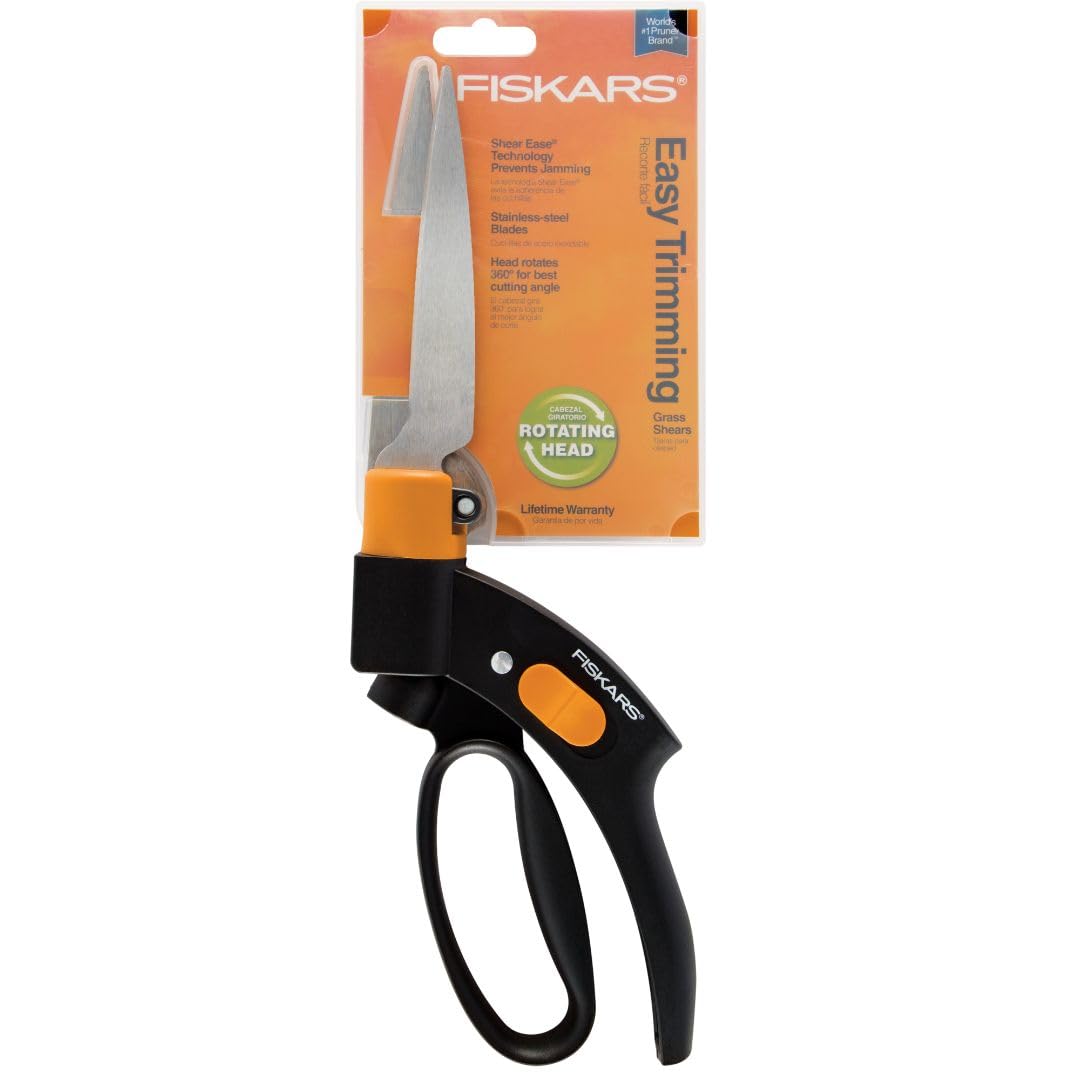
Customer Reviews and Overall Assessment
Customer reviews for the Fiskars Shear Ease Grass Shears overwhelmingly positive, praising their ease of use, effectiveness, and durability. Users particularly appreciate the shears’ ability to tackle tough trimming tasks with minimal effort. Overall, the Fiskars Shear Ease Grass Shears consistently earn high ratings and positive feedback, solidifying their reputation as a must-have tool for any gardener.
A Gardener’s Essential Tool
In conclusion, the Fiskars Shear Ease Grass Shears prove to be an invaluable addition to any gardener’s toolkit. Their combination of precision, ease of use, and durability makes them ideal for trimming edges, borders, and hard-to-reach areas with minimal strain. Whether you’re a seasoned gardener or a novice homeowner, the Fiskars Shear Ease Grass Shears will transform your grass trimming experience into a task you’ll relish rather than dread.
Advanced Features of the Fiskars Shear Ease Grass Shears
Beyond the core functionalities, the Fiskars Shear Ease Grass Shears boast several advanced features that enhance user experience:
-
PowerLever Technology: This innovative technology incorporates a built-in leverage system within the handles. By squeezing the handles, you activate the PowerLever, multiplying your cutting force and making it easier to tackle thick or stubborn grass.
-
Lifetime Blade Warranty: Fiskars’ commitment to quality is evident in their lifetime blade warranty. This warranty provides peace of mind, knowing that any manufacturer’s defect in the blades will be covered for the lifespan of the shears.
-
Replaceable Blade Design: While the blades are built to last, the option to replace them once they become excessively worn ensures continued optimal performance. Fiskars offers readily available replacement blades, guaranteeing longevity for your shears.
Beyond Grass Trimming: Exploring Additional Uses
The versatility of the Fiskars Shear Ease Grass Shears extends beyond simply trimming grass. Here are some unexpected yet effective ways to utilize these shears in your garden:
-
Trimming Flowers and Shrubs: The sharp blades make them ideal for shaping flower beds and maintaining the desired size and form of small shrubs or bushes.
-
Harvesting Herbs and Vegetables: Use the shears to precisely cut herbs like basil or chives, or harvest delicate vegetables like green beans.
-
Deadheading Flowers: Encourage new blooms by using the shears to remove spent flowers from your plants, promoting continued growth and a vibrant floral display.
Fiskars Shear Ease Grass Shears: A Sustainable Choice
For environmentally conscious gardeners, the Fiskars Shear Ease Grass Shears are a sustainable choice. Here’s why:
-
Durable Construction: Built to last, these shears minimize waste associated with disposing of frequently replaced, low-quality tools.
-
Reduced Power Consumption: Compared to gas-powered trimmers, the shears require no electricity or fuel, reducing your carbon footprint.
-
Effortless Maintenance: Routine cleaning and occasional sharpening are all that’s required to maintain the shears, minimizing the need for replacements and additional resource consumption.
By choosing the Fiskars Shear Ease Grass Shears, you’re not only investing in a quality tool but also making a responsible choice for a more sustainable future.

Gardener’s Essential: The Best Weed Puller Tools Garden
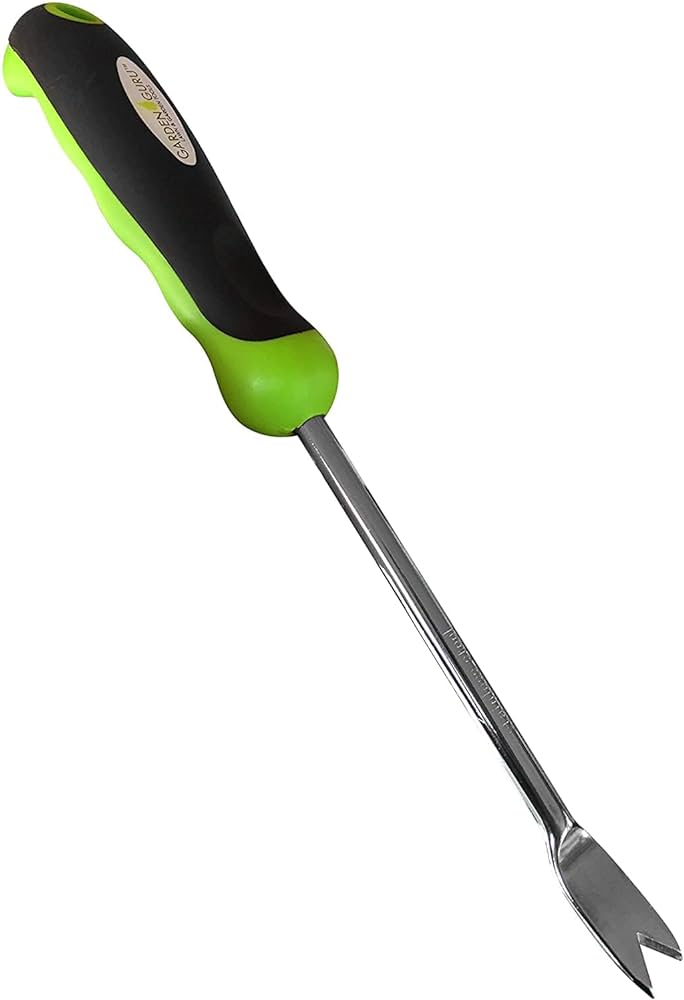
A lush, thriving garden is a sight to behold, a testament to the dedication and care of its owner. However, this idyllic vision can be marred by the unwelcome presence of weeds, those persistent botanical intruders that compete for nutrients, water, and sunlight, hindering the growth of your prized plants. Fortunately, the battle against weeds is not without its heroes – weed puller tools stand ready to assist you in reclaiming your garden’s glory.
Understanding the Weed Menace
Before delving into the world of weed puller tools, it’s crucial to recognize the enemy we face. Weeds are not merely unsightly; they pose a significant threat to the health and well-being of your garden. Their relentless growth can:
-
Rob nutrients: Weeds siphon essential nutrients from the soil, depriving your cherished plants of the sustenance they need to thrive.
-
Block sunlight: As weeds sprout and spread, they cast shadows over your plants, limiting their access to the vital sunlight they require for photosynthesis.
-
Harbor pests and diseases: Weeds can provide a haven for harmful pests and diseases, further jeopardizing the health of your garden ecosystem.

An Arsenal of Weed Puller Tools
In the fight against weeds, a diverse range of weed puller tools stands as your arsenal. Each tool brings unique strengths to the battle, making them suitable for different weed types and garden conditions. Let’s explore the most common weed puller tools:
-
Hand weeders: These compact tools are ideal for tackling individual weeds in small areas.
-
Fork-style hand weeders: Their pronged design effectively loosens and extracts weeds, including taproots.
-
Dandelion pullers: Specifically designed to combat the stubborn dandelions, these tools feature a deep, V-shaped claw that grips the root firmly.
-
Hori-hori knives: Versatile tools, hori-hori knives combine a sharp blade for cutting weeds with a serrated edge for loosening soil.

-
-
Long-handled weeders: For larger garden areas, long-handled weeders offer leverage and reduce strain on your back.
-
Stand-up weed pullers: These tools allow you to remove weeds while standing upright, eliminating the need for stooping or bending.
-
Lever-action weeders: Utilizing a lever mechanism, these weeders amplify your force, making it easier to pry out stubborn weeds.
-
Rolling weeders: These innovative tools feature rotating wheels that effectively dislodge and remove weeds from the soil.
-
Choosing Your Weed Puller Weapon
With an array of weed puller tools at your disposal, selecting the right one for your garden is essential. Consider these factors:
-
Weed type: Different tools are better suited for specific weed types. For instance, dandelion pullers excel against dandelions, while fork-style weeders handle taproots effectively.
-
Garden size: For larger gardens, long-handled weeders provide reach and reduce strain. For smaller areas, hand weeders are maneuverable and efficient.
-
Personal preferences: Consider your physical limitations and preferences. Some tools require more force or involve bending, while others offer ergonomic designs.

Unleashing Effective Weed Removal Techniques
To maximize the effectiveness of your weed puller tools, employ proper technique and timing:
-
Timing is key: Target weeds when they are young and still small, making them easier to remove.
-
Hand weeders: Dig around the root of the weed with the prongs or blade, ensuring you extract the entire root.
-
Long-handled weeders: Position the tool over the weed and press firmly into the soil. For lever-action weeders, apply pressure on the lever to dislodge the weed. For rolling weeders, roll the tool over the weeds to uproot them.
-
Additional tips: Loosen the soil before pulling, dispose of weeds properly to prevent regrowth, and consider using natural weed control methods.
Cultivating a Weed-Free Garden
Prevention is always better than cure. Implement these strategies to minimize weed growth:
-
Regular weeding: Make weed pulling a regular part of your garden maintenance routine.
-
Mulching: Apply a layer of mulch around your plants to suppress weed growth and retain soil moisture.
-
Healthy soil: Maintain healthy soil by adding organic matter and ensuring proper drainage.

Long-Term Weed Control Strategies
For persistent weed problems, consider these long-term strategies:
-
Natural weed deterrents: Utilize natural weed deterrents like vinegar, salt, or cornmeal gluten.
-
Weed-resistant plants: Choose plants that are naturally resistant to common weeds in your area.
-
Professional help: For severe weed infestations, seek assistance from a professional gardener or landscaper.
-
Conquering Weed Challenges
Despite your best efforts, some weeds may prove particularly troublesome. Here’s how to tackle common challenges:
-
Stubborn weeds: For deep-rooted weeds, like dandelions, a combination of tools and techniques might be necessary. Try digging around the root with a hori-hori knife before using a dandelion puller.
-
Hard-to-reach areas: For weeds growing in tight spaces or near delicate plants, a hand weeder with a sharp tip or a narrow claw can offer more maneuverability.
-
Fast-growing weeds: Certain weeds may seem to reappear overnight. Persistence is key! Regularly weeding and applying weed control methods will eventually deplete their seed bank in the soil.
-
Selecting the Perfect Hand Weeder
Hand weeders, with their compact size and versatility, are a gardener’s trusty companions for tackling weeds in tight spaces or around delicate plants. However, with an array of options available, choosing the ideal hand weeder can feel overwhelming. Here’s a breakdown of two common types to help you find your perfect match:
-
Fork-style hand weeder:
-
Design: Featuring a forked head with two or three prongs, this classic hand weeder excels at extracting weeds with taproots. The prongs dig deep into the soil, allowing you to grasp the root firmly and pull it out in its entirety.
-
Applications: Ideal for dandelions, thistles, and other deep-rooted weeds. The narrow prongs can also navigate between closely spaced plants without causing damage.
-
-
Claw hand weeder:
-
Design: This hand weeder features a single, V-shaped claw at the tip. The claw effortlessly grips the base of the weed stem, making it suitable for removing shallow-rooted weeds and weeds growing in cracks or crevices.
-
Applications: Perfect for eliminating crabgrass, purslane, and other shallow-rooted weeds. The claw design also proves effective for grabbing weeds growing close to walls or edging.
-
The Power of Leverage: Long-Handled Weed Pullers
For larger gardens or those who suffer from back pain, long-handled weed pullers offer a solution. These tools leverage your body weight and provide greater reach, reducing strain and making weeding a more comfortable and efficient experience. Let’s explore two popular long-handled weed pullers:
-
Stand-up weed puller:
-
Design: This innovative tool boasts a long handle and a foot pedal mechanism. The forked head resembles a traditional hand weeder, but on a larger scale.
-
Applications: Ideal for those with back problems or who prefer to weed while standing upright. The foot pedal allows you to easily push the prongs into the soil and extract weeds without bending.
-
-
Lever-action weed puller:
-
Design: This long-handled weed puller features a lever mechanism that amplifies your pulling force. The head typically consists of claws or prongs for gripping weeds.
-
Applications: Well-suited for stubborn weeds with deep roots or thick stems. The lever mechanism provides the extra power needed to remove these weeds without excessive effort.
-
-
Conclusion: A Weed-Free Future Awaits
By equipping yourself with the right weed puller tools, knowledge, and strategies, you can transform your garden from a weed-infested battlefield into a flourishing haven for your prized plants. Remember, consistency and a proactive approach are key to achieving a weed-free paradise. So, arm yourself with your chosen weed puller tool, embrace the satisfaction of a weed-free garden, and watch your plants flourish!
-

VIVOSUN Grow Tents: Your Guide to Indoor Gardening Success
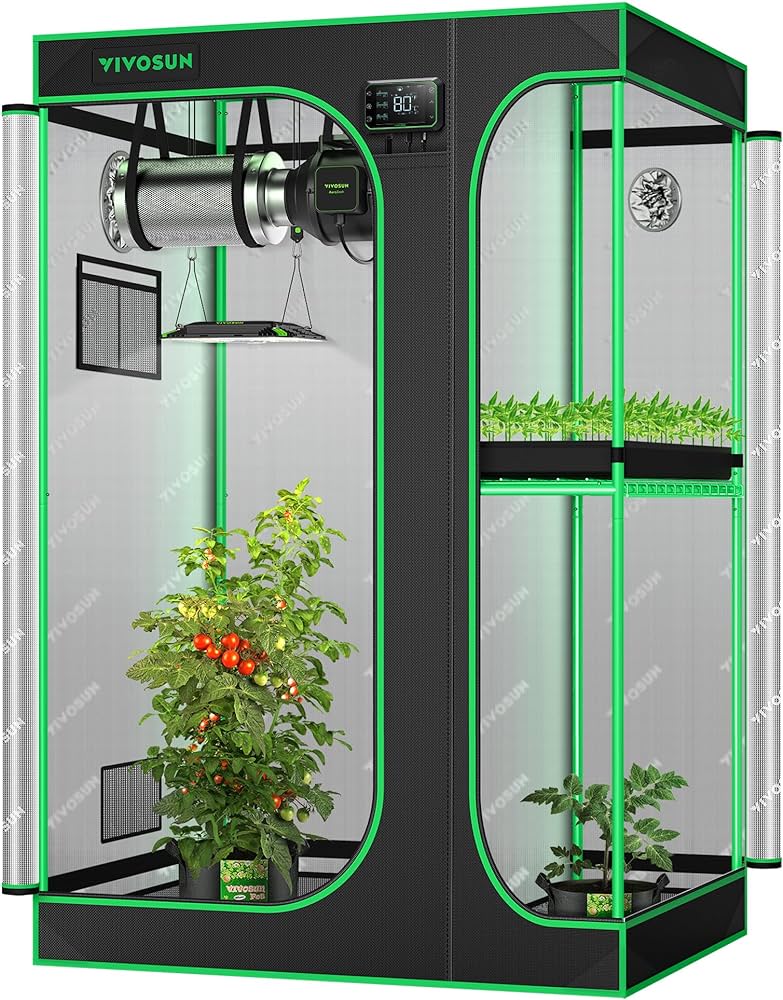
I. Introduction
VIVOSUN grow tents are a popular choice for indoor gardeners of all levels of experience. They provide a controlled environment that is ideal for growing plants year-round, regardless of the climate outside. With a VIVOSUN grow tent, you can create the perfect conditions for your plants to thrive, resulting in increased yields and healthier crops.
II. Types of VIVOSUN Grow Tents
VIVOSUN grow tents come in a variety of sizes and styles to suit your specific needs. Here are some of the most popular options:
- Size: VIVOSUN grow tents are available in a wide range of sizes, from small 2′ x 2′ tents to large 8′ x 8′ tents. The size of the tent you choose will depend on the number of plants you want to grow and the available space in your home.
- Features: VIVOSUN grow tents come with a variety of features, such as ventilation ports, reflective Mylar lining, and easy-access doors. Some tents also include additional features, such as grow lights and ventilation systems.
- Applications: VIVOSUN grow tents can be used to grow a variety of plants, including fruits, vegetables, herbs, and flowers. They are also popular for growing cannabis.
III. Key Features of VIVOSUN Grow Tents
VIVOSUN grow tents are known for their high quality and durability. Here are some of the key features that make them a popular choice for indoor gardeners:
- High-quality materials: VIVOSUN grow tents are made from high-quality materials that are designed to withstand the rigors of indoor gardening. The tent frame is made from heavy-duty steel, and the tent cover is made from durable, tear-resistant canvas.
- Durable construction: VIVOSUN grow tents are built to last. The double-stitched seams and reinforced corners ensure that the tent can withstand even the most demanding growing conditions.
- Reflective Mylar lining: The reflective Mylar lining helps to maximize light penetration and distribution, which can lead to increased yields.
- Ventilation ports: VIVOSUN grow tents come with multiple ventilation ports that allow for proper air circulation. This helps to prevent the buildup of heat and humidity, which can lead to mold and mildew growth.
- Easy assembly: VIVOSUN grow tents are easy to assemble, even for beginners. The tents come with clear instructions and all of the necessary hardware.

IV. Benefits of Using VIVOSUN Grow Tents
There are many benefits to using VIVOSUN grow tents, including:
- Optimal growing conditions for plants: VIVOSUN grow tents provide the perfect environment for plants to thrive. They allow you to control the temperature, humidity, and light levels, which are all essential for plant growth.
- Increased yields: With a VIVOSUN grow tent, you can create the ideal conditions for your plants to produce high yields.
- Protection from pests and diseases: VIVOSUN grow tents help to protect your plants from pests and diseases. The enclosed environment keeps pests out, and the controlled temperature and humidity levels help to prevent the growth of mold and mildew.
- Control over the growing environment: With a VIVOSUN grow tent, you have complete control over the growing environment. You can adjust the temperature, humidity, and light levels to create the perfect conditions for your plants.
- Year-round growing capabilities: VIVOSUN grow tents allow you to grow plants year-round, regardless of the climate outside. This is especially beneficial for gardeners who live in areas with cold winters or short growing seasons.
V. How to Choose the Right VIVOSUN Grow Tent
When choosing a VIVOSUN grow tent, there are a few factors to consider:
- Size: The size of the tent you choose will depend on the number of plants you want to grow and the available space in your home.
- Features: Consider the features that are important to you, such as ventilation ports, reflective Mylar lining, and easy-access doors.
- Applications: Think about what type of plants you want to grow. Some tents are specifically designed for growing certain types of plants.
- Budget: VIVOSUN grow tents come in a variety of price ranges. Set a budget for yourself and then choose a tent that fits within your budget.
VI. Setting Up Your VIVOSUN Grow Tent
Setting up your VIVOSUN grow tent is easy. Here are the basic steps:
- Choose a location for your tent: Find a location in your home that is free from drafts and has access to electricity and water.
- Assemble the tent frame: Follow the instructions that come with your tent to assemble the frame.
- Attach the tent cover: Once the frame is assembled attach the tent cover to the frame. Make sure all the zippers and closures are securely fastened. 4. Install the ventilation system: Most VIVOSUN tents come with ventilation ports. You can install an inline fan and carbon filter system to exhaust stale air and odors from the tent. 5. Set up your lighting system: Grow lights are essential for indoor plant growth. Choose the right type of grow lights for the plants you are growing and install them according to the manufacturer’s instructions.
VII. Growing Plants in Your VIVOSUN Grow Tent
Now that your VIVOSUN grow tent is set up, you’re ready to start growing plants! Here are the basic steps:
- Select the right growing medium: Popular choices include soil, coco coir, and hydroponic systems. Choose the medium that is best suited for the type of plants you want to grow.
- Plant your seeds or seedlings: Follow the planting instructions for the specific plants you are growing.
- Water and fertilize your plants regularly: The amount of water and fertilizer your plants will need will vary depending on the type of plant, the stage of growth, and the growing medium. Be sure to research the specific needs of your plants.
- Provide adequate lighting: The amount of light your plants will need will vary depending on the type of plant. Most plants need between 12 and 18 hours of light per day during the vegetative stage.
- Monitor the temperature and humidity: The ideal temperature and humidity levels for your plants will vary depending on the type of plant. Most plants thrive in temperatures between 68°F and 78°F (20°C and 26°C) and humidity levels between 40% and 60%.
- Control pests and diseases: Regularly inspect your plants for signs of pests and diseases. There are a number of organic and non-organic methods for controlling pests and diseases in your grow tent.

VIII. Harvesting Your Plants
When your plants are mature, it’s time to harvest! Here are some things to keep in mind:
- Signs that your plants are ready to harvest: The specific signs that your plants are ready to harvest will vary depending on the type of plant. However, some general signs include the formation of flowers or fruits, the changing color of leaves, and the trichomes (tiny hairs) on cannabis plants turning cloudy or amber.
- Harvesting techniques: The harvesting techniques you use will also vary depending on the type of plant. Some plants can be harvested whole, while others need to be trimmed or cut. Be sure to research the proper harvesting techniques for the specific plants you are growing.
- Curing and drying your harvest: Once you have harvested your plants, you will need to cure and dry them properly. This process helps to preserve the flavor and potency of your harvest.
IX. Troubleshooting Common Problems
Even with the best care, you may encounter some problems when growing plants in your VIVOSUN grow tent. Here are a few common problems and how to troubleshoot them:
- Pests and diseases: Regularly inspect your plants for signs of pests and diseases. There are a number of organic and non-organic methods for controlling pests and diseases in your grow tent.
- Nutrient deficiencies: If your plants are not getting the nutrients they need, they will show signs of nutrient deficiency. These signs can vary depending on the specific nutrient deficiency, but some common signs include yellowing leaves, stunted growth, and poor yields. To correct a nutrient deficiency, you will need to adjust your fertilizer regimen.
- Lighting problems: If your plants are not getting enough light, they will become leggy and stretched. If they are getting too much light, the leaves may bleach or burn. Adjust your lighting system as needed to provide the correct amount of light for your plants.
- Temperature and humidity problems: The ideal temperature and humidity levels for your plants will vary depending on the type of plant. Monitor the temperature and humidity levels in your grow tent and adjust them as needed.

X. Cleaning and Maintaining Your VIVOSUN Grow Tent
Proper cleaning and maintenance will help to extend the life of your VIVOSUN grow tent and prevent the growth of pests and diseases. Here are some tips:
- Regular cleaning: Clean the inside of your grow tent regularly with a disinfectant solution. Be sure to remove all plant debris and allow the tent to dry completely before using it again.
- Inspect for damage and repairs as needed: Regularly inspect your grow tent for damage, such as rips or tears. Repair any damage promptly to prevent further problems.
- Store the tent properly when not in use: When you are not using your grow tent, store it in a cool, dry place out of direct sunlight.


Exploring the Benefits of a Heavy Duty Carport Canopy for Vehicle Protection
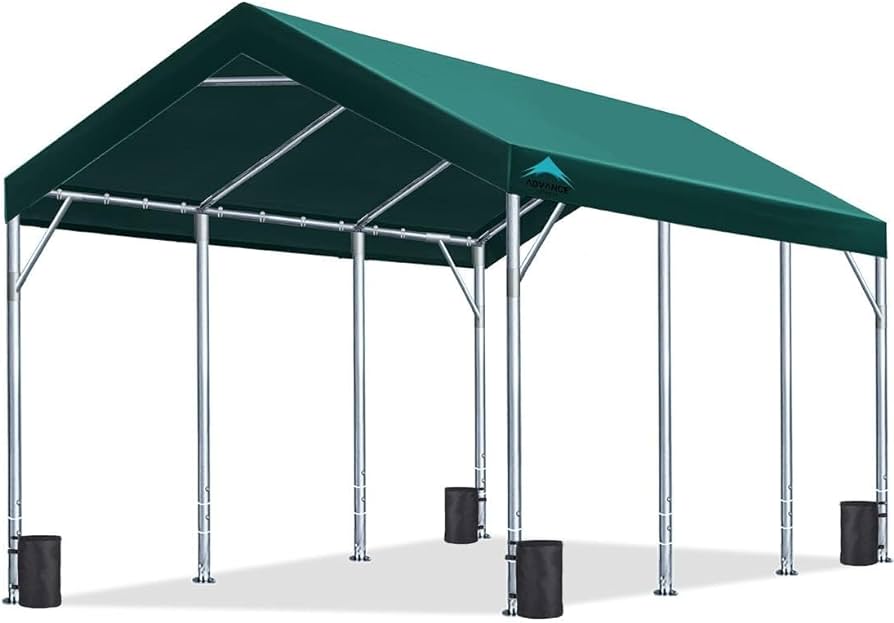
Introduction
- A. Introduce the growing popularity of carport canopies as a practical and affordable solution for protecting vehicles and outdoor spaces
- B. Highlight the key features and benefits of heavy-duty carport canopies, emphasizing their durability, versatility, and weather resistance
- C. Briefly discuss the target audience for this product and its potential applications in both residential and commercial settings
Understanding the Need for Vehicle Protection
- A. Factors Contributing to Vehicle Damage: Explain the various factors that can damage vehicles parked outdoors, such as harsh weather conditions, falling debris, and bird droppings
- B. Consequences of Unprotected Vehicles: Discuss the negative consequences of leaving vehicles unprotected, including paint fading, rust formation, and interior damage
- C. The Value of Vehicle Protection: Emphasize the importance of protecting vehicles from the elements, highlighting the financial and aesthetic benefits of doing so

Heavy Duty Carport Canopies: A Superior Solution
- A. Durability and Strength: Explain how heavy-duty carport canopies are designed to withstand heavy snow loads, strong winds, and other extreme weather conditions
- B. Versatility and Customization Options: Discuss the wide range of size, style, and material options available for heavy-duty carport canopies, allowing for customization to suit individual needs
- C. Weather Resistance and Protection: Highlight the weather-resistant materials used in heavy-duty carport canopies, providing protection against UV rays, rain, snow, and dust

Versatile Applications for Carport Canopies
- A. Residential Vehicle Protection: Explain the primary use of heavy-duty carport canopies in residential settings, providing shelter for cars, trucks, motorcycles, and other vehicles
- B. Commercial and Industrial Applications: Discuss the commercial applications of heavy-duty carport canopies, such as protecting outdoor workspaces, storage areas, and recreational vehicles
- C. Temporary Shelters and Event Spaces: Highlight the versatility of carport canopies as temporary shelters for outdoor events, parties, and gatherings
Choosing the Right Heavy Duty Carport Canopy
- A. Size Considerations: Explain the importance of considering the size of the vehicles and the available space when selecting a carport canopy
- B. Material Selection: Discuss the different materials used for carport canopies, including PVC-coated polyester, galvanized steel, and aluminum, and their respective advantages
- C. Permanent vs. Temporary Installations: Consider the intended use and desired portability when deciding between a permanent carport canopy installation or a temporary setup
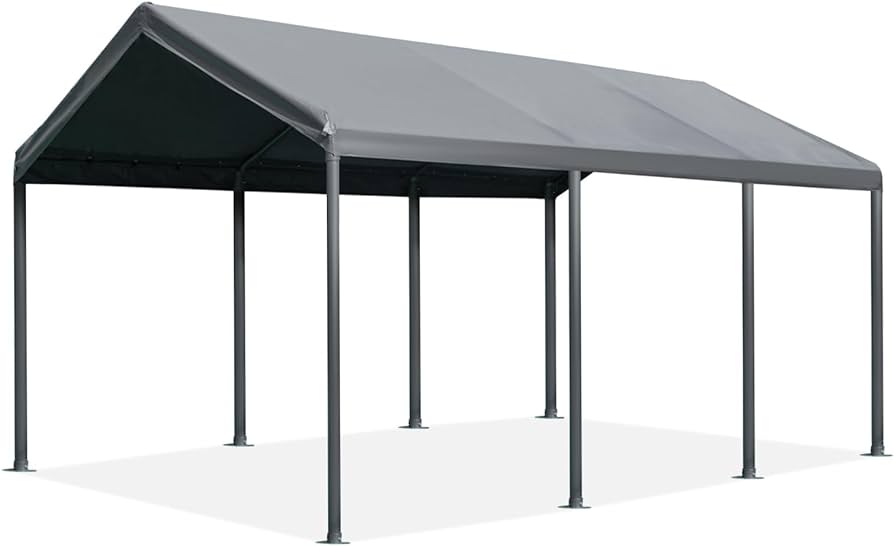
Installation and Assembly
- A. Permanent Installation: Provide an overview of the steps involved in the permanent installation of a heavy-duty carport canopy, including anchoring, framing, and canopy attachment
- B. Temporary Assembly: Explain the process of assembling a temporary carport canopy, emphasizing the importance of following the manufacturer’s instructions and ensuring proper stability
- C. Professional Installation Options: Discuss the benefits of seeking professional installation services for permanent carport canopies, ensuring proper safety and compliance with local regulations
Maintenance and Care
- A. Regular Cleaning and Inspection: Explain the importance of regular cleaning and inspection of the carport canopy to maintain its appearance and functionality
- B. Addressing Damage and Repairs: Discuss the steps to address minor damage or repairs, such as patching tears or tightening loose connections
- C. Professional Maintenance Services: Consider hiring professional maintenance services for more complex repairs or routine inspections, especially for permanent installations

Safety Considerations
- A. Proper Installation and Anchoring: Emphasize the importance of proper installation and anchoring to ensure the carport canopy can withstand strong winds and heavy snow loads
- B. Regular Inspections and Maintenance: Reiterate the importance of regular inspections and maintenance to identify potential safety hazards and address them promptly
- C. Snow and Ice Removal: Explain the safe removal of snow and ice from the carport canopy to prevent excessive weight and structural damage
Conclusion
- A. Reaffirm the Benefits of Heavy Duty Carport Canopies: Summarize the key benefits of heavy-duty carport canopies, highlighting their durability, versatility, and weather protection
- B. Recommend Carport Canopies for Vehicle Protection: Recommend heavy-duty carport canopies as a valuable investment for protecting vehicles and outdoor spaces
- C. Encourage Further Research and Exploration: Encourage further research and exploration of different carport canopy options and installation services to find the best solution for individual needs
Additional Considerations for Heavy Duty Carport Canopies
Beyond the core aspects, here are some additional factors to consider when exploring heavy-duty carport canopies:
- Local Permits and Regulations: In some areas, local building codes or homeowner association regulations may govern the installation of permanent carport canopies. It’s crucial to research and obtain any necessary permits before proceeding with installation.
- Aesthetics and Design: Heavy-duty carport canopies are available in a variety of styles and colors. Consider the aesthetics of your home or property and choose a design that complements the overall look.
- Privacy Needs: If privacy is a concern, consider adding side panels or privacy screens to your carport canopy for a more enclosed space. This can be particularly beneficial for commercial applications or when storing valuable equipment.
- Lighting Options: For nighttime use or added security, consider incorporating lighting fixtures into your carport canopy design. This can improve visibility and provide a sense of safety around parked vehicles or work areas.
- Budgetary Considerations: Heavy-duty carport canopies range in price depending on size, material, and complexity of design. Determine your budget beforehand and compare prices from various vendors to find the best value for your needs.
A Shelter for Your Vehicles and More
Heavy-duty carport canopies offer a practical and versatile solution for protecting your vehicles and outdoor spaces from the elements. Their durability, weather resistance, and range of customization options make them a valuable asset for both residential and commercial applications.
By considering the factors outlined in this guide, you can make an informed decision when choosing a heavy-duty carport canopy that perfectly suits your needs. From safeguarding your prized car to creating a functional workspace, a well-chosen carport canopy can provide a reliable shelter for years to come. So, invest in peace of mind and protection, and enjoy the many benefits that heavy-duty carport canopies offer.
-
VI. Installation and Assembly: A Step-by-Step Approach
Installing a heavy-duty carport canopy can be a rewarding DIY project, but it requires careful planning and execution. Here’s a breakdown of the general steps involved, categorized by permanent and temporary installations:
A. Permanent Installation:
- Planning and Permitting: Before diving into construction, ensure you have the necessary permits and understand any local regulations regarding carport canopy installations. Gather all the required tools and materials based on your chosen canopy model.
- Site Preparation: It is crucial to choose a level and stable location for your carport canopy. Once a suitable location is identified, clear the area of any debris or obstructions. Moreover, ensure proper drainage to prevent water pooling around the base of the structure.
Foundation and Post Installation: Depending on your chosen model, the foundation might involve concrete footings or anchor posts driven into the ground. To ensure secure anchoring, it is essential to follow the manufacturer’s instructions meticulously.
Frame Assembly: To assemble the frame of the carport canopy, use the provided hardware. This typically involves connecting pre-cut metal or wooden beams according to the manufacturer’s diagrams.
Canopy Attachment: After assembling the frame, secure the canopy fabric to it using straps, hooks, or other fastening methods specified in the instructions. It’s important to ensure proper tension and alignment for a taut and secure canopy.
- Final Touches: Once the main structure is complete, address any finishing touches like gutters, drainage systems, or side panels (if included) as per your design preferences.
B. Temporary Assembly:
- Preparation and Location: Choose a flat, stable location with ample space for the temporary carport canopy. Ensure the ground is clear and free of any obstacles.
- Frame Assembly: Follow the manufacturer’s instructions to assemble the frame of the temporary carport canopy. This typically involves connecting collapsible poles or pre-fabricated sections.
- Canopy Attachment: Secure the canopy fabric to the assembled frame using the provided hooks, clips, or fastening mechanisms. Ensure proper tension for stability.
- Guying and Anchoring: For temporary installations, it’s crucial to utilize guylines and ground anchors to provide additional stability, especially in windy conditions. Secure the guylines to designated points on the frame and stake the anchors firmly into the ground.
- Disassembly and Storage: When not in use, disassemble the temporary carport canopy for easy storage. Follow the manufacturer’s instructions for proper disassembly and storage to protect the components from damage.

Exploring the Netatmo Wireless Anemometer: Wind Speed and Direction Sensor
In the dynamic realm of weather monitoring, accurate wind measurements stand as the cornerstone for understanding wind patterns, predicting weather conditions, and ensuring safety. The Netatmo Wireless Anemometer with Wind Speed and Direction Sensor emerges as a beacon of innovation, empowering homeowners and weather enthusiasts alike with its reliable and versatile capabilities. This comprehensive guide delves into the intricacies of this exceptional device, unveiling its features, benefits, and diverse applications.
 I. Introduction
I. Introduction
A. The Significance of Wind Measurement
Wind measurement plays a pivotal role in weather monitoring, providing invaluable insights into wind speed, direction, and gust patterns. These measurements are indispensable for various applications, encompassing weather forecasting, aviation safety, and wind energy generation.
B. Unveiling the Netatmo Wireless Anemometer
The Netatmo Wireless Anemometer stands as a cutting-edge wind measurement device, seamlessly integrating with the Netatmo Weather Station. Employing ultrasonic technology, it delivers precise wind speed and direction measurements, offering a reliable and maintenance-free solution.
C. Key Features and Benefits
The Netatmo Wireless Anemometer boasts a remarkable array of features that set it apart from traditional wind gauges. Its ultrasonic technology guarantees accurate wind measurements, while its wireless connectivity eliminates the need for complex wiring. Furthermore, its compatibility with the Netatmo Weather Station provides a comprehensive weather monitoring system.

II. Delving into the Mechanism
A. Ultrasonic Technology: Ensuring Precision
The Netatmo Wireless Anemometer harnesses the power of ultrasonic technology to measure wind speed and direction. It emits ultrasonic pulses and measures the time it takes for these pulses to travel against and with the wind. This method provides highly accurate and reliable wind measurements.
B. Wireless Communication: Seamless Integration
The Netatmo Wireless Anemometer communicates wirelessly with the Netatmo Weather Station, eliminating the need for cumbersome cables or wires. This wireless connectivity ensures easy installation and allows for flexible placement of the anemometer.
C. Real-time and Historical Data Access
The Netatmo Wireless Anemometer provides real-time wind speed and direction data on the Netatmo Weather Station app. Users can also access historical wind data to track trends and patterns over time.
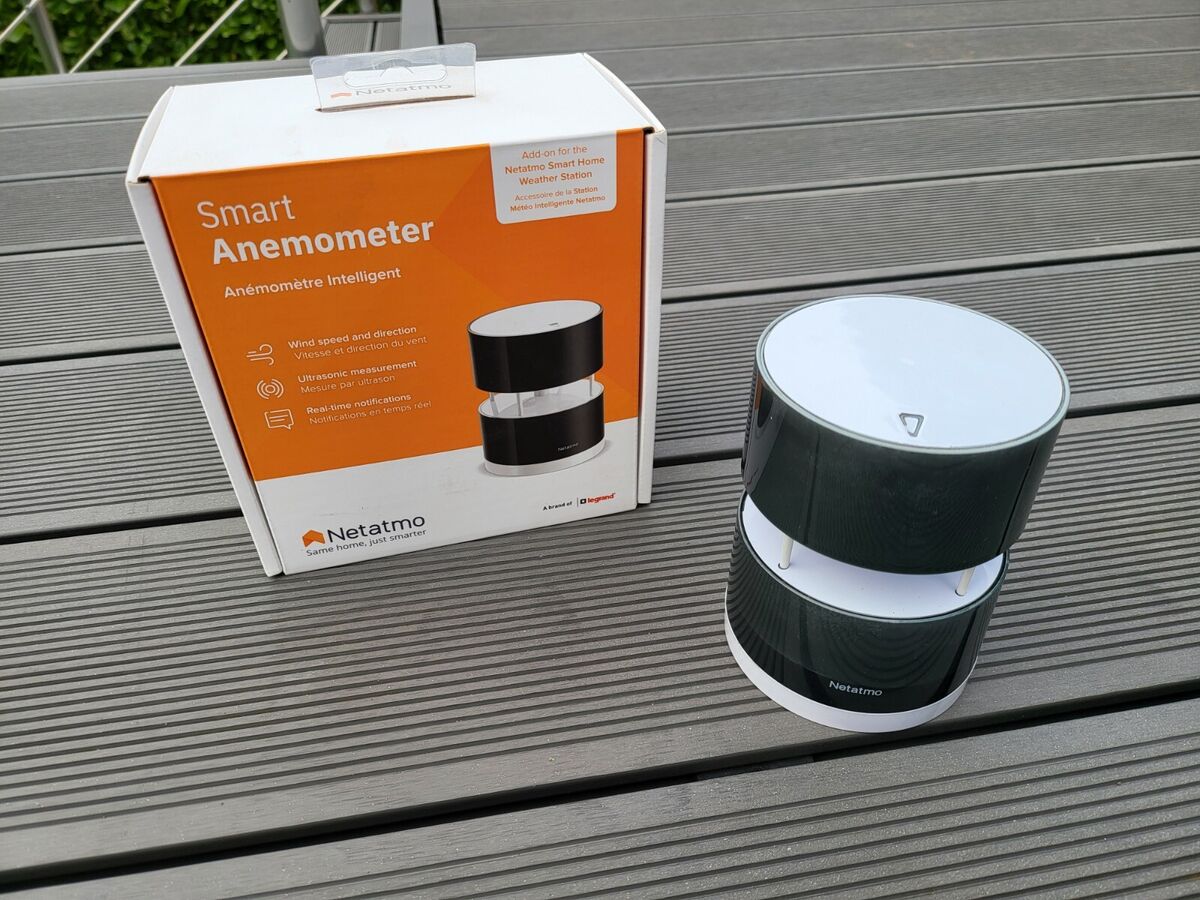
III. Embracing the Benefits
A. Accurate and Reliable Wind Measurements
The Netatmo Wireless Anemometer’s ultrasonic technology ensures highly accurate and reliable wind measurements, providing users with confidence in the data they receive.
B. Ease of Installation and Maintenance
The wireless connectivity and lack of moving parts make the Netatmo Wireless Anemometer remarkably easy to install and maintain. No complex wiring or regular maintenance is required.
C. Comprehensive Weather Monitoring System
When integrated with the Netatmo Weather Station, the Netatmo Wireless Anemometer provides a comprehensive weather monitoring system, offering insights into temperature, humidity, pressure, and wind conditions.

IV. Diverse Applications
A. Home Weather Monitoring
Homeowners can utilize the Netatmo Wireless Anemometer to monitor wind conditions around their homes, gaining valuable information for weather preparedness and outdoor activities.
B. Weather Enthusiasts and Hobbyists
Weather enthusiasts and hobbyists can employ the Netatmo Wireless Anemometer to track wind patterns, study weather phenomena, and expand their understanding of meteorology.
C. Professional Applications
The Netatmo Wireless Anemometer can be used in professional settings, such as research institutions and weather stations, to supplement existing wind measurement systems and provide additional data points.
V. Installation and Setup
A. Choosing the Installation Location
Select an unobstructed outdoor location with a clear view of the sky, away from trees, buildings, and other structures that could interfere with wind measurements.
B. Mounting the Anemometer
Securely mount the anemometer using the provided mounting bracket and screws. Ensure the anemometer is level and aligned with the direction of prevailing winds.
C. Connecting to the Netatmo Weather Station
Follow the instructions in the Netatmo Weather Station app to connect the anemometer to the weather station. This process typically involves entering a unique code found on the anemometer.

VI. Troubleshooting Common Issues
A. Inaccurate Wind Measurements
If wind measurements appear inaccurate, check for obstructions near the anemometer, ensure it is level, and verify the connection to the Netatmo Weather Station.
B. Loss of Wireless Connection
If the anemometer loses connection to the weather station, check the battery level and ensure the distance between the anemometer and the weather station is within the specified range.
C. App Issues
If you encounter issues with the Netatmo Weather Station app, restart the app, check for app updates and ensure your smartphone or tablet meets the minimum system requirements for the app. Rebooting your device can sometimes resolve app malfunctions as well.
VII. Conclusion: Empowering Weather Knowledge
By understanding the intricacies of the Netatmo Wireless Anemometer, you can transform your weather monitoring capabilities. This innovative device empowers you with accurate and reliable wind data, fostering a deeper understanding of the dynamic world of weather. Whether you’re a homeowner seeking weather preparedness information or a weather enthusiast fascinated by wind patterns, the Netatmo Wireless Anemometer serves as a valuable tool. With its ease of use and integration with the Netatmo Weather Station, it offers a comprehensive solution for monitoring your local weather conditions. So, embrace the power of wind measurement and embark on a journey of weather discovery with the Netatmo Wireless Anemometer by your side.
VIII. Additional Considerations
A. Battery Life
The Netatmo Wireless Anemometer typically boasts a long battery life, often lasting for several years depending on usage. The specific battery life can vary based on factors like the frequency of data transmission and weather conditions. The Netatmo Weather Station app will provide notifications when the battery level is low.
B. Durability and Weather Resistance
The Netatmo Wireless Anemometer is designed to withstand harsh weather conditions, including rain, snow, and strong winds. Its durable construction ensures reliable operation year-round.
C. Compatibility
Ensure compatibility between the Netatmo Wireless Anemometer and your existing Netatmo Weather Station model before purchasing. While most models are compatible, it’s always a good practice to check for compatibility beforehand.
IX. Final Thoughts
The Netatmo Wireless Anemometer stands as a testament to innovation in weather monitoring. Its user-friendly design, combined with its advanced ultrasonic technology, makes it an exceptional choice for anyone seeking accurate and reliable wind data. Whether you’re a seasoned weather enthusiast or simply curious about the wind patterns in your backyard, the Netatmo Wireless Anemometer empowers you to unlock a deeper understanding of the world around you. With this comprehensive guide as your resource, you can confidently explore the features, benefits, and applications of this remarkable device. So, take control of your weather knowledge and embrace the power of wind measurement with the Netatmo Wireless Anemometer.

Maximizing Indoor Gardening Success with LED Grow Lights
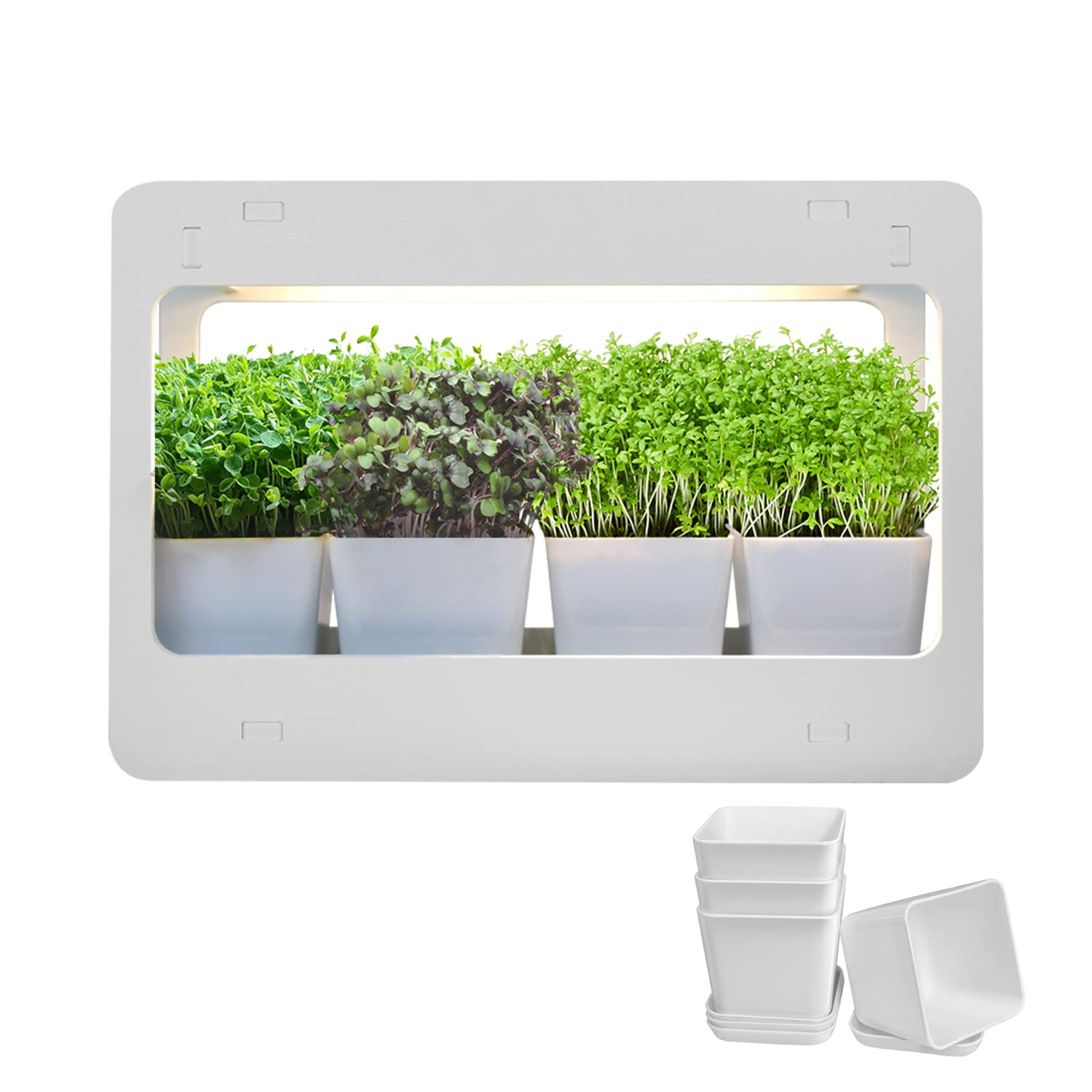
In the captivating realm of horticulture, indoor gardening has emerged as a flourishing pursuit, transforming homes and apartments into verdant oases. While sunlight remains the primary source of energy for plant growth, advancements in LED technology have revolutionized the indoor gardening landscape, providing a viable and versatile alternative to natural light. Whether you’re a seasoned green thumb or a budding plant enthusiast, understanding the intricacies of indoor gardening with LED grow lights is essential for cultivating a thriving indoor garden.
I. Introduction
A. The Allure of Indoor Gardening
Indoor gardening has captivated individuals worldwide, offering the opportunity to nurture plants and create a verdant haven within their living spaces. This trend is fueled by the desire to connect with nature, enhance air quality, and enjoy the therapeutic benefits of gardening. Indoor gardens provide a sense of tranquility and well-being, transforming homes into vibrant sanctuaries.
B. LED Grow Lights: A Revolutionary Transformation
LED grow lights have revolutionized indoor gardening by providing an energy-efficient, versatile, and spectrum-controllable alternative to traditional fluorescent or incandescent grow lights. These lights emit specific wavelengths of light that can be tailored to the unique needs of different plant species, enabling precise control over plant growth and development. Unlike traditional grow lights, LED lights are energy-efficient, producing minimal heat and extending their lifespan.
C. Selecting the Ideal LED Grow Light
When choosing an LED grow light for your indoor garden, several factors should be carefully considered. The light’s spectrum, intensity, coverage area, and energy efficiency are crucial aspects to evaluate. Additionally, the light’s mounting options, durability, and compatibility with your specific growing setup should be taken into account.
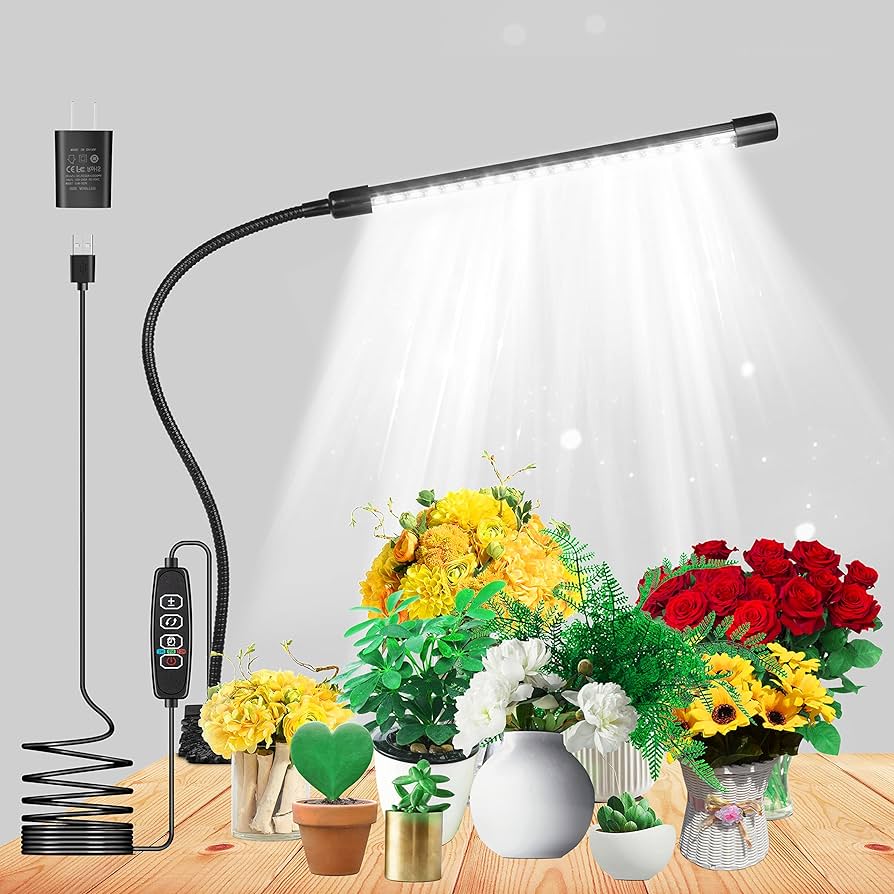
II. Types of LED Grow Lights for Indoor Gardening
A. Single-Color LED Grow Lights: Targeted Illumination
Single-color LED grow lights emit specific wavelengths of light, such as blue or red, which are particularly beneficial for certain stages of plant growth. Blue light promotes vegetative growth, stimulating the development of leaves and stems. Red light encourages flowering and fruiting, triggering the production of blossoms and fruits.
B. Full-Spectrum LED Grow Lights: Mimicking Natural Sunlight
Full-spectrum LED grow lights emit a blend of wavelengths that mimic natural sunlight, providing a comprehensive light source for overall plant health and development. These lights are well-suited for a wide range of plant species, from leafy greens to flowering plants. Their comprehensive spectrum ensures that plants receive all the essential wavelengths they need for optimal growth.
C. Hybrid LED Grow Lights: Tailored Illumination
Hybrid LED grow lights combine single-color and full-spectrum LEDs, offering the flexibility to tailor the light spectrum to specific plant needs. This allows for more precise control over plant growth and development. For instance, you can use a hybrid light with a higher proportion of blue light during the vegetative stage and then switch to a light with more red light during the flowering stage.
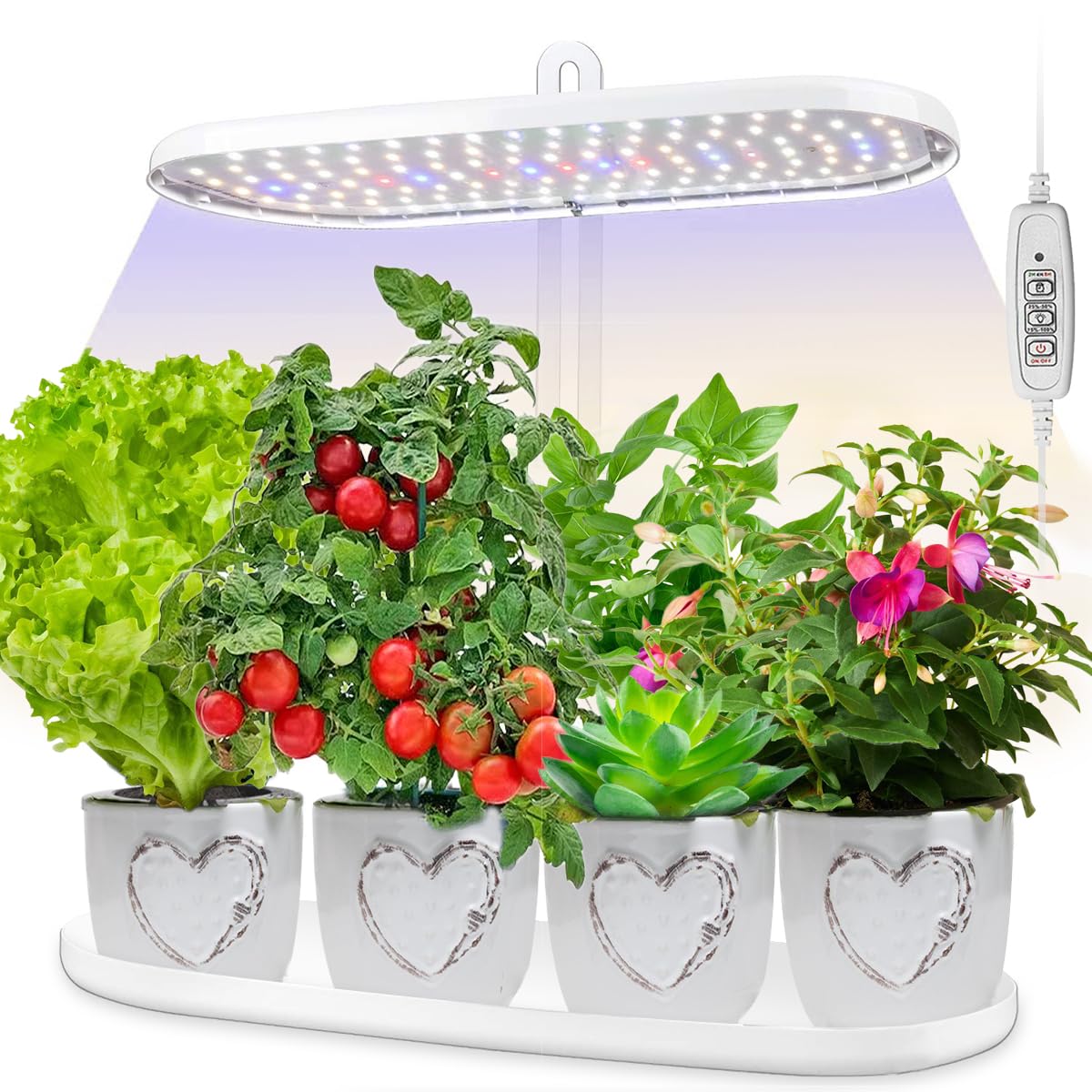
III. Establishing Your Indoor Garden with LED Grow Lights
A. Selecting the Right Location: Setting the Stage
Choose a location for your indoor garden that receives adequate ventilation and has access to a power outlet. Consider factors like temperature, humidity, and exposure to natural light. Ideally, select a spot that receives some indirect sunlight to supplement the artificial light from your LED grow lights.
B. Choosing Suitable Containers and Growing Medium: Nurturing Roots
Select containers with drainage holes and a size appropriate for the plants you intend to grow. Ensure the containers are deep enough to accommodate the root systems of your plants. Choose a well-draining, aerated growing medium, such as potting mix or coco coir. These media provide the necessary support and aeration for root growth.
C. Planting and Transplanting: Giving Life to Seeds and Seedlings
Follow the recommended planting depth and spacing for your chosen seeds or seedlings. Ensure the growing medium is moist but not soggy. Water the seeds or seedlings gently after planting to settle the soil and provide initial moisture. For seedlings, carefully remove them from their original containers and gently transplant them into the prepared pots.
D. Positioning Your LED Grow Lights: Ensuring Optimal Lighting
Suspend your LED grow lights at an appropriate height above the plants, ensuring even light distribution. Adjust the height as the plants grow. The ideal distance between the lights and the plants depends on the specific light intensity and the plant species. As a general rule, start with a distance of a few inches and adjust as needed.
E. Establishing an Appropriate Lighting Schedule: Mimicking Day and Night
Provide your plants with the optimal amount of light based on their species and growth stage. Most plants require 12-18 hours of light per day. Use a timer to automate the lighting schedule, ensuring consistent light cycles for your plants. Adjust the lighting duration based on the specific needs of your plants.
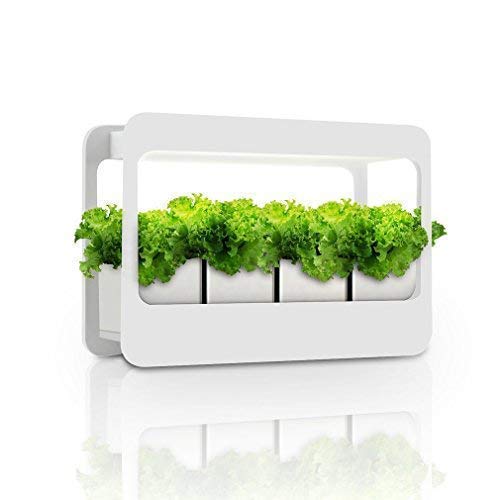
IV. Maintaining an Indoor Garden with LED Grow Lights
A. Regular Watering: Finding the Balance
Water your plants thoroughly when the top inch of soil feels dry to the touch. Avoid overwatering, which can lead to root rot. Overwatering deprives roots of oxygen, hindering their ability to absorb water and nutrients. When watering, ensure the water drains freely from the drainage holes to prevent waterlogging.
B. Monitoring Nutrient Levels: Feeding Your Plants
Use a balanced liquid fertilizer as needed to provide essential nutrients for healthy plant growth. Follow the recommended dilution rates and application frequency on the fertilizer packaging. Over-fertilizing can damage plant roots and harm the soil. Signs of nutrient deficiency include stunted growth, yellowing leaves, and poor flowering or fruiting.
C. Controlling Temperature and Humidity: Creating a Favorable Environment
Maintain an ideal temperature range for your plants, typically between 65-80°F (18-27°C). Most houseplants thrive within this range. Monitor the temperature using a thermometer and adjust room temperature or ventilation as needed. Aim for humidity levels around 50-60%. Grouping plants together or using a humidifier can help increase humidity levels if necessary.
D. Pruning and Pest Control: Maintaining Plant Health
Regularly prune your plants to encourage healthy growth, improve air circulation, and promote a bushier appearance. Remove any diseased or damaged leaves to prevent the spread of disease. Monitor for pests such as aphids, mealybugs, or spider mites. If pests are present, isolate affected plants and use organic pest control methods whenever possible.

V. Troubleshooting Common Indoor Gardening Problems with LED Grow Lights
A. Stretched or Leggy Plants: A Lighting Issue
Stretched or leggy plants with elongated stems and sparse foliage may indicate insufficient light intensity or improper light positioning. Adjust the light height closer to the plants or increase the light intensity to provide adequate light for healthy growth. Ensure even light distribution across the plant canopy.
B. Yellowing Leaves: Identifying the Cause
Yellowing leaves can be caused by various factors, such as overwatering, nutrient deficiencies, or root rot. Assess your watering practices and adjust if necessary. Check for signs of root rot, such as mushy or discolored roots. If root rot is present, repot the plant in fresh potting mix and adjust your watering habits. Consider using a balanced fertilizer to address nutrient deficiencies.
C. Drooping or Wilting Plants: Addressing Underlying Issues
Drooping or wilting plants may indicate underwatering, excessive heat, or root issues. Check the soil moisture and water thoroughly if the top inch of soil feels dry. Adjust the room temperature or ventilation if the temperature is excessively high. Inspect the roots for signs of root rot and repot the plant if necessary.
D. Slow Growth or Lack of Flowering: Potential Causes
Slow growth or lack of flowering can be attributed to several factors, including insufficient light, nutrient deficiencies, or incorrect temperature and humidity levels. Ensure your lighting schedule and intensity are appropriate for the plant species. Address any nutrient deficiencies with balanced fertilization. Maintain the ideal temperature and humidity range for your plants.
VI. Conclusion: Cultivating a Thriving Indoor Oasis
By understanding the intricacies of indoor gardening with LED grow lights, you can cultivate a flourishing indoor oasis, brimming with vibrant plant life. From selecting the ideal LED grow light to maintaining proper watering and fertilization practices, this guide equips you with the knowledge to nurture a thriving indoor garden. As you witness your plants flourish under the gentle glow of LED lights, you’ll experience the joy of indoor gardening and the satisfaction of cultivating a verdant sanctuary within your own home.
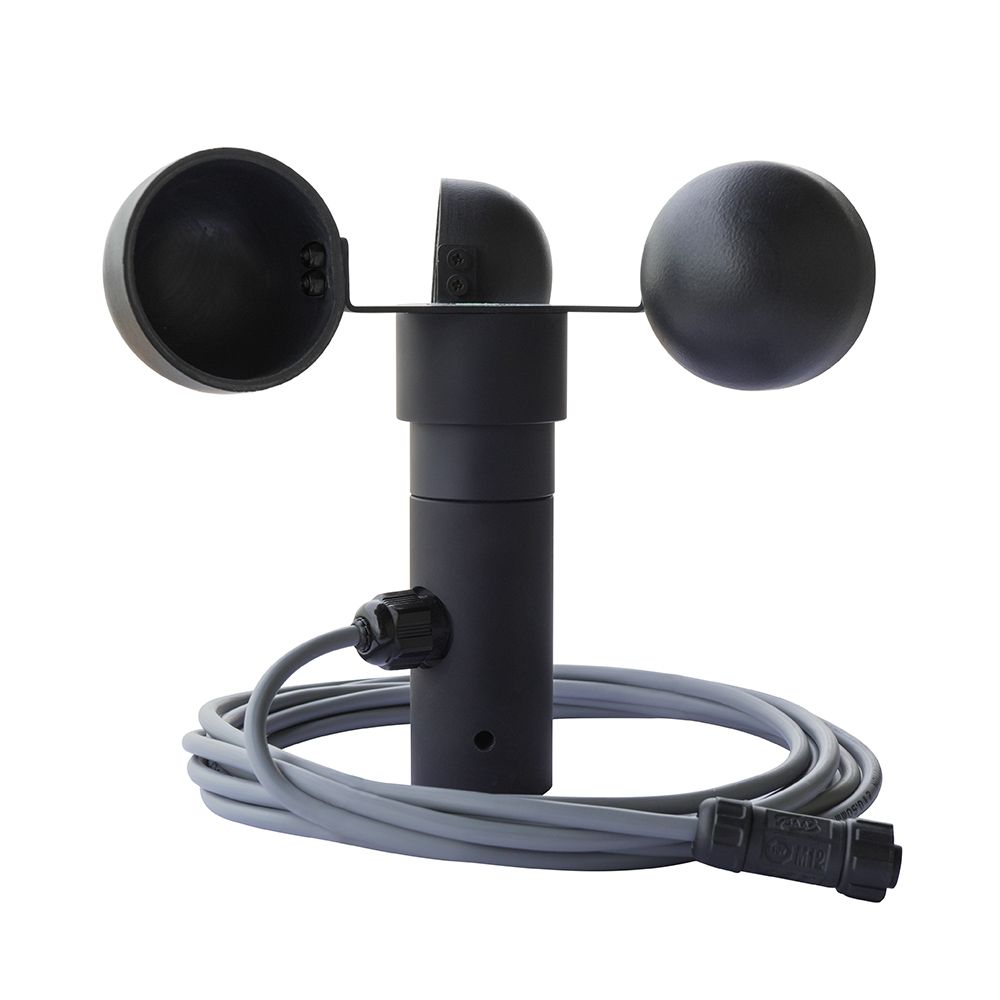
Understanding and Monitoring Wind Speed: The Significance of Wind Speed Sensors
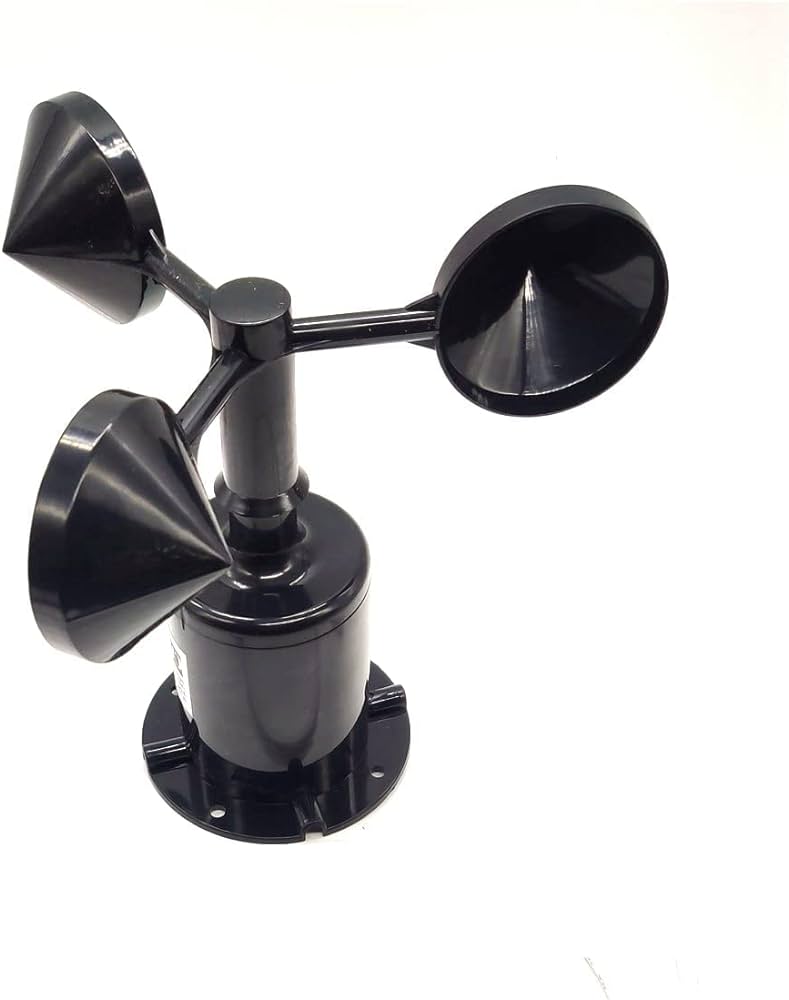
From the gentle breeze that caresses our faces to the powerful gusts that whip through trees, wind is an ever-present force in our world. It shapes weather patterns, drives renewable energy sources, and influences countless human activities. Understanding and monitoring wind speed is therefore essential for a wide range of applications, from ensuring safety and optimizing energy production to advancing scientific research. This is where wind speed sensors emerge as indispensable tools, providing accurate and reliable measurements of this dynamic force.
Unveiling Wind Speed: A Measure of Wind’s Velocity
Wind speed, simply put, is the rate at which air moves from one place to another. It is typically measured in meters per second (m/s) or miles per hour (mph). Wind speed is influenced by a complex interplay of factors, including pressure differences between air masses, air temperature, the Earth’s rotation, and local topography.
Historically, wind speed was estimated using the Beaufort scale, a qualitative system devised by Admiral Sir Francis Beaufort in the early 19th century. This scale, based on observed effects like wave height and tree movement, provided a general indication of wind strength but lacked precision.
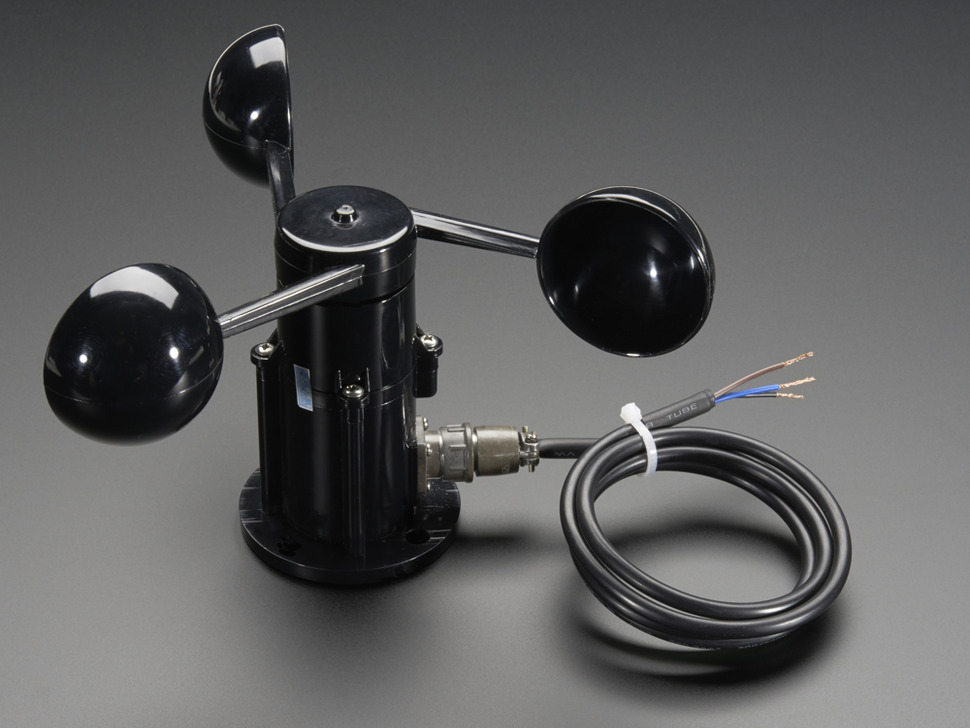
Applications of Wind Speed Sensors: A Versatile Tool
In today’s world, wind speed sensors have become indispensable tools across a diverse range of fields. In meteorology, these sensors play a crucial role in weather forecasting and understanding atmospheric dynamics. Accurate wind speed measurements are essential for predicting storms, tracking wind patterns, and issuing timely warnings for hazardous weather conditions.
Renewable energy, particularly wind power, relies heavily on wind speed sensors. These sensors are used to monitor wind conditions at potential wind turbine sites, ensuring optimal turbine placement and maximizing energy generation. By measuring wind speed and direction, wind energy operators can adjust turbine pitch and blade rotation to extract the most energy from the available wind resource.
Aviation safety is another area where wind speed sensors are paramount. Pilots and air traffic controllers rely on accurate wind speed data for safe takeoff, landing, and navigation. Wind speed can significantly impact aircraft performance, affecting lift, drag, and fuel consumption. Understanding wind conditions is crucial for making informed decisions during flight operations and minimizing risks.
In construction and engineering, wind speed sensors are used to assess wind loads on structures, ensuring their stability and safety. Wind can exert significant forces on buildings, bridges, and other structures, and accurate wind speed measurements are essential for designing structures that can withstand these forces.
Wind speed sensors also find applications in sports and recreation, particularly activities like sailing, windsurfing, and kite flying. These sensors provide wind speed readings that help participants choose appropriate equipment, assess conditions, and optimize their performance.

The Significance of Wind Speed Monitoring: Gaining Insights into Wind Patterns
Monitoring wind speed not only provides real-time data for immediate applications but also offers valuable insights into long-term wind patterns. This information is crucial for various purposes, including:
-
Early warning systems: Wind speed monitoring is essential for developing effective early warning systems for high winds, storms, and potential hazards. By tracking wind patterns, authorities can issue timely alerts and warnings to communities, allowing people to take precautionary measures and protect themselves from harm.
-
Environmental monitoring: Wind speed data plays a significant role in environmental monitoring, helping us understand air quality, pollution dispersion, and climate change. Wind patterns can influence the transport of air pollutants, and understanding these patterns is crucial for developing effective air quality management strategies.
-
Industrial applications: In various industries, wind speed monitoring is used to optimize processes that rely on wind, such as ventilation and cooling systems. For instance, in factories and warehouses, wind speed sensors can control ventilation fans to maintain comfortable working conditions and reduce energy consumption.
-
Agricultural practices: Wind speed monitoring is beneficial for agricultural practices, particularly in irrigation systems and crop protection. Wind speed data can be used to optimize irrigation schedules, ensuring efficient water usage and preventing crop damage from strong winds.
-
Research and development: Wind speed sensors are indispensable tools for research and development in various fields, including wind energy, meteorology, and climate science. By collecting and analyzing long-term wind speed data, researchers can gain insights into wind patterns, resource potential, and the impacts of climate change.
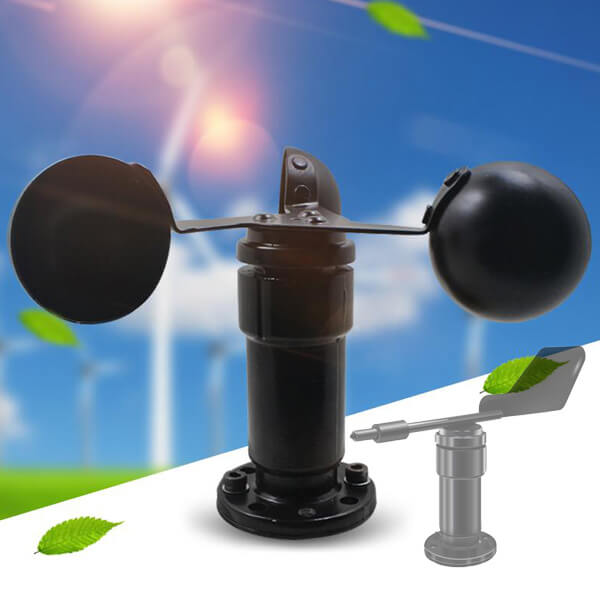
Types of Wind Speed Sensors: Measuring the Wind’s Force
A variety of wind speed sensors are available, each with its own strengths and limitations. The choice of sensor depends on the specific application and the desired level of accuracy and reliability. Some common types of wind speed sensors include:
-
- Cup anemometers: These sensors utilize rotating cups to measure wind speed based on the principle of relative motion. The speed of the rotating cups is proportional to the wind speed.
- Ultrasonic anemometers: Employing ultrasonic pulses, these sensors measure wind speed by calculating the time difference between pulses sent upstream and downstream. This method provides high accuracy and is less affected
by wind direction compared to cup anemometers.
- Hot-wire anemometers: These sensors measure wind speed by sensing the cooling effect of air on a heated wire. The rate of cooling is proportional to the wind speed and offers high sensitivity for measuring low wind speeds. However, they are delicate and require careful calibration.
- Pitot tubes: These sensors utilize the principle of fluid dynamics to measure wind speed based on the difference in pressure between two points. One point faces directly into the wind, while the other is positioned at a right angle. This method is commonly used in aircraft to measure airspeed.
- Lidar anemometers: These innovative sensors use laser beams to measure wind speed remotely, particularly over long distances. They are well-suited for measuring wind profiles in the atmosphere and studying wind patterns across large areas.
Factors to Consider When Choosing a Wind Speed Sensor: Selecting the Right Tool
Selecting the right wind speed sensor requires careful consideration of various factors:
-
Accuracy and reliability: The sensor should provide precise and consistent wind speed measurements that meet the needs of the application.
-
Measurement range: The sensor’s measurement range should be suitable for the expected wind speeds in the intended environment. Some sensors may not be suitable for very high or very low wind speeds.
-
Operating environment: The sensor’s ability to withstand environmental conditions like temperature, humidity, and exposure to dust or debris is crucial.
-
Response time: The sensor’s response time, which is the time it takes to register changes in wind speed, should be appropriate for the application. Some applications require sensors with very fast response times.
-
Data transmission and output: The sensor’s compatibility with data transmission and output options is important. Some sensors offer analog or digital signals, while others may have wireless data transmission capabilities.
Installation and Maintenance of Wind Speed Sensors: Ensuring Optimal Performance
To ensure accurate and reliable measurements, proper installation and maintenance of wind speed sensors are essential:
-
Proper installation: The sensor should be mounted in an unobstructed location, free from turbulence caused by buildings or other structures. This allows the sensor to measure the true wind speed.
-
Regular calibration: Periodic calibration of the sensor is crucial to maintain its accuracy. The calibration frequency depends on the sensor type, operating environment, and desired level of accuracy.
-
Protective measures: Taking steps to protect the sensor from extreme weather conditions, physical damage, and corrosion is essential for ensuring its longevity and performance.
-
Data management: Establishing a system for collecting, storing, and analyzing wind speed data is necessary to utilize the information effectively. This may involve using data loggers, software tools, and data visualization techniques.

Challenges and Limitations of Wind Speed Sensors: Addressing Measurement Issues
Despite their vast benefits, wind speed sensors face certain challenges and limitations:
-
Accuracy in complex environments: Measuring wind speed accurately in complex environments with gusty winds or turbulent airflow can be challenging. Proper sensor selection and installation techniques can help mitigate this issue.
-
Extreme weather conditions: Extreme temperatures, high humidity, or harsh weather events like hail or ice storms can affect sensor performance. Selecting sensors designed for the intended environment is crucial.
-
Data interpretation: Wind speed data needs to be interpreted in the context of the specific application. Factors like wind direction, gusts, and local topography can influence the impact of wind speed.
-
Sensor calibration and maintenance: Regular calibration and proper maintenance are essential for maintaining data quality. Failure to do so can lead to inaccurate wind speed measurements.
The Future of Wind Speed Sensors: Advancing Measurement Technology
The future of wind speed sensors is bright, with continuous advancements in technology leading to enhanced capabilities:
-
Enhanced accuracy and sensitivity: New sensor technologies are being developed to offer even higher accuracy and sensitivity for measuring wind speed, providing more precise data for various applications.
-
Miniaturization and integration: Sensors are becoming smaller, lighter, and more integrated, making them suitable for a wider range of applications, including integration with drones and mobile weather stations.
-
Wireless communication and data logging: The incorporation of wireless communication capabilities and data logging features will enable remote monitoring and analysis of wind speed data, improving efficiency and accessibility.
-
Smart sensors and machine learning: Integrating smart sensor technology and machine learning algorithms into wind speed sensors will allow for real-time insights, predictive analytics, and improved decision-making in various fields.